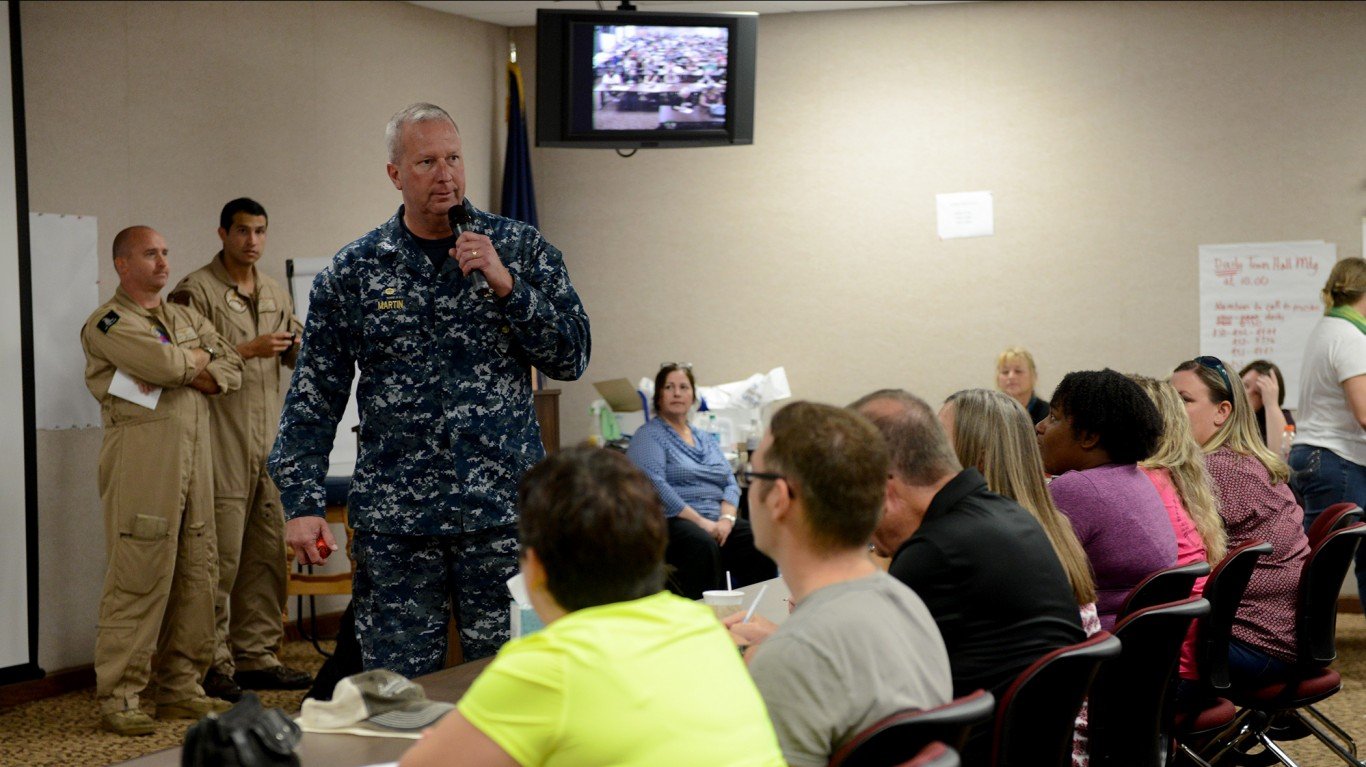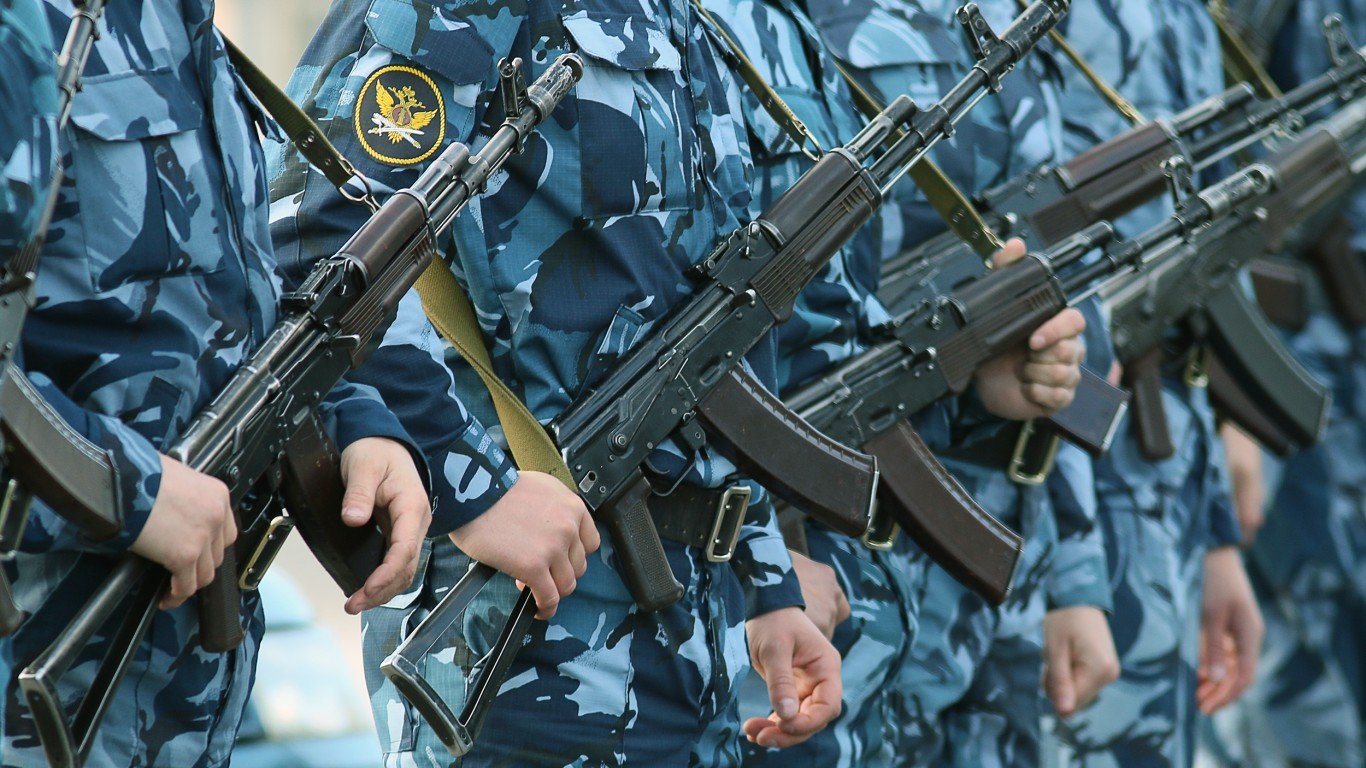

The United States has by far the strongest military in the world. To maintain its global presence, the United States operates more than 500 military bases on foreign sites across every continent except for Antarctica.
These facilities are used for training and troop deployments, for maintaining and testing weapons systems, for research and education, and for aircraft testing. Given the space these exercises often require, the physical size of these installations can be considerable.
24/7 Wall St. has compiled a list of America’s 50 largest military bases overseas. The facilities are listed in order of physical size, according to data from the Department of Defense’s Base Structure Report — Fiscal Year 2018 Baseline. The report provides characteristics of bases overseas as of Sept. 30, 2017, including base size by acreage, and the cost of replacing the base in terms of today’s construction costs and standards.
Many of the bases on this list were initially established as a practical war-time necessity. Of the 50 installations on the list, 18 are in Japan, and many of those are on the island of Okinawa, a legacy of the intense fighting there during World War II. Nine bases are in South Korea as the United States and South Korea partnered to defend against an attack from communist North Korea following the Korean War. Here is a look at the costliest wars in U.S. history.
Many installations are named after servicemen who made the ultimate sacrifice for their country. Some of these men were awarded the Medal of Honor, the most prestigious U.S. military decoration. Here is a list of the most decorated war heroes in U.S. history.
Click here to see America’s largest military bases around the world
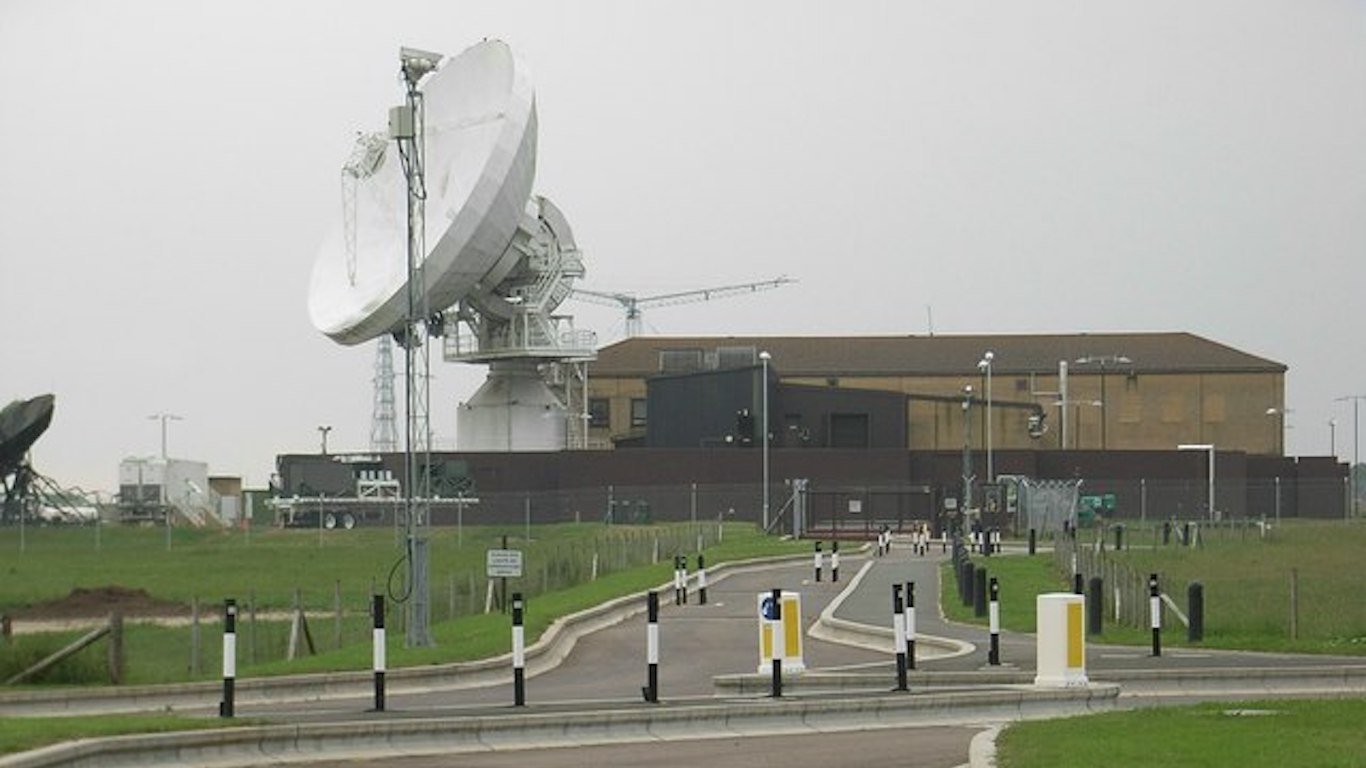
50. RAF Croughton, United Kingdom
> Base size: 694 acres
> Cost of base: $473.2 million
> Service branch: Air Force
> Nearest city: Croughton
RAF Croughton is located in the central part of the United Kingdom, about 70 miles northwest of London. It was founded as a Royal Air Force base in 1938. After World War II, the base was deactivated and then given over to the U.S. military and has served as a communications hub for the U.S. Air Force.
[in-text-ad]
49. Daegu Air Base, South Korea
> Base size: 698 acres
> Cost of base: $756.7 million
> Service branch: Air Force
> Nearest city: Taegu
Daegu is a major military facility operated by the United States in South Korea. It is located near the city of Daegu, the third most populous city in South Korea. The base was created in 1921 by the Japanese Empire, and the United States took it over after World War II.
48. Ikego Housing Area, Japan
> Base size: 714 acres
> Cost of base: $1.2 billion
> Service branch: Navy
> Nearest city: Ikego
The Ikego facility was an ammunition depot in Zushi City used by the Japanese Navy during World War II. The housing facility for the U.S. Navy opened in 1996 and has 853 units housing 2,500 family members who live on the base.
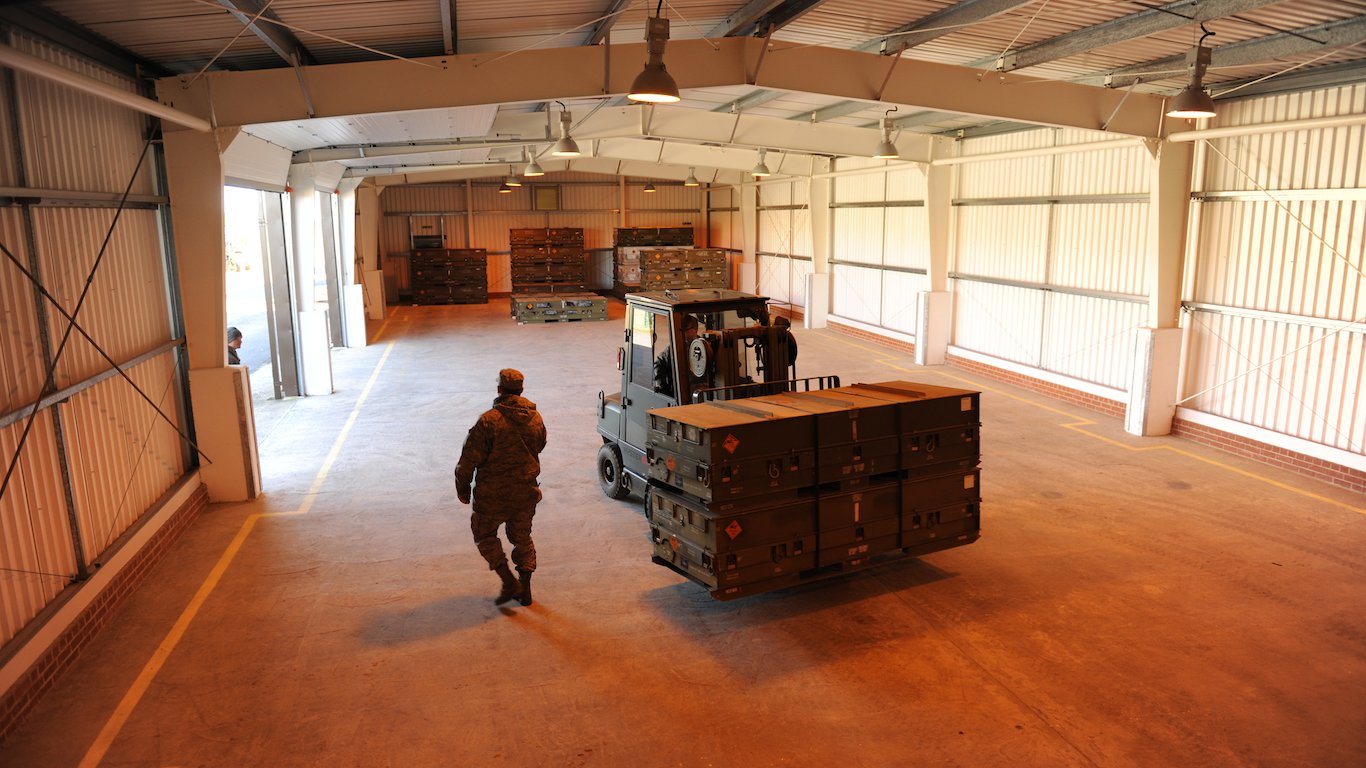
47. RAF Welford Ammo Storage Area, United Kingdom
> Base size: 736 acres
> Cost of base: $320.5 million
> Service branch: Air Force
> Nearest city: Welford
RAF Welford, the base for the 420th Munitions Squadron, is located 40 minutes south of Oxford. The base is the second-largest munitions storage area for conventional weapons in Europe and provides ammunition stores for all members of NATO.
[in-text-ad-2]
46. Camp Hovey, South Korea
> Base size: 763 acres
> Cost of base: $588.3 million
> Service branch: Army
> Nearest city: Camp Hovey
The camp, named in honor of MSG Howard Hovey, a Distinguished Service Cross recipient who died during the Korean War, is strategically important. The camp is close to the city of Tongduchon, which is about 40 miles north of Seoul and just 11 miles south of the Demilitarized Zone. The purpose of the base is to deter aggression from North Korea. The camp is home to about 2,500 active duty American military personnel and several hundred civilians.
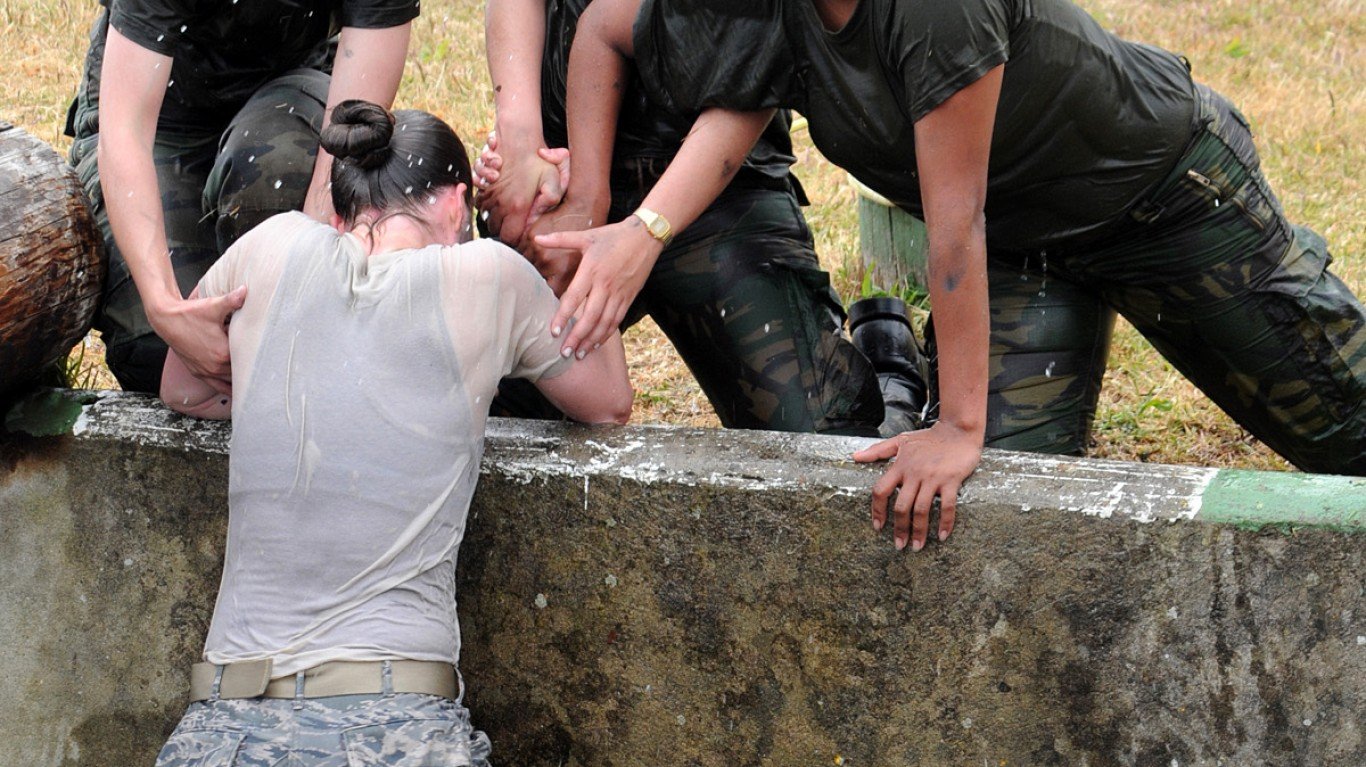
45. Lajes Field, Portugal
> Base size: 973 acres
> Cost of base: $1.5 billion
> Service branch: Air Force
> Nearest city: Lajes
Lajes Field in Portugal is located on the island of Terceira in the Azores archipelago, about 900 miles west of Lisbon. Allied forces used the base during World War II. The facility is known as the “Crossroads of the Atlantic,” Lajes Field is an important installation for NATO countries — Portugal is one of 12 founding NATO members — because of its proximity to North Africa and the Middle East. The 65th Air Base Wing, the largest American military unit in the Azores, is stationed on the island.
[in-text-ad]
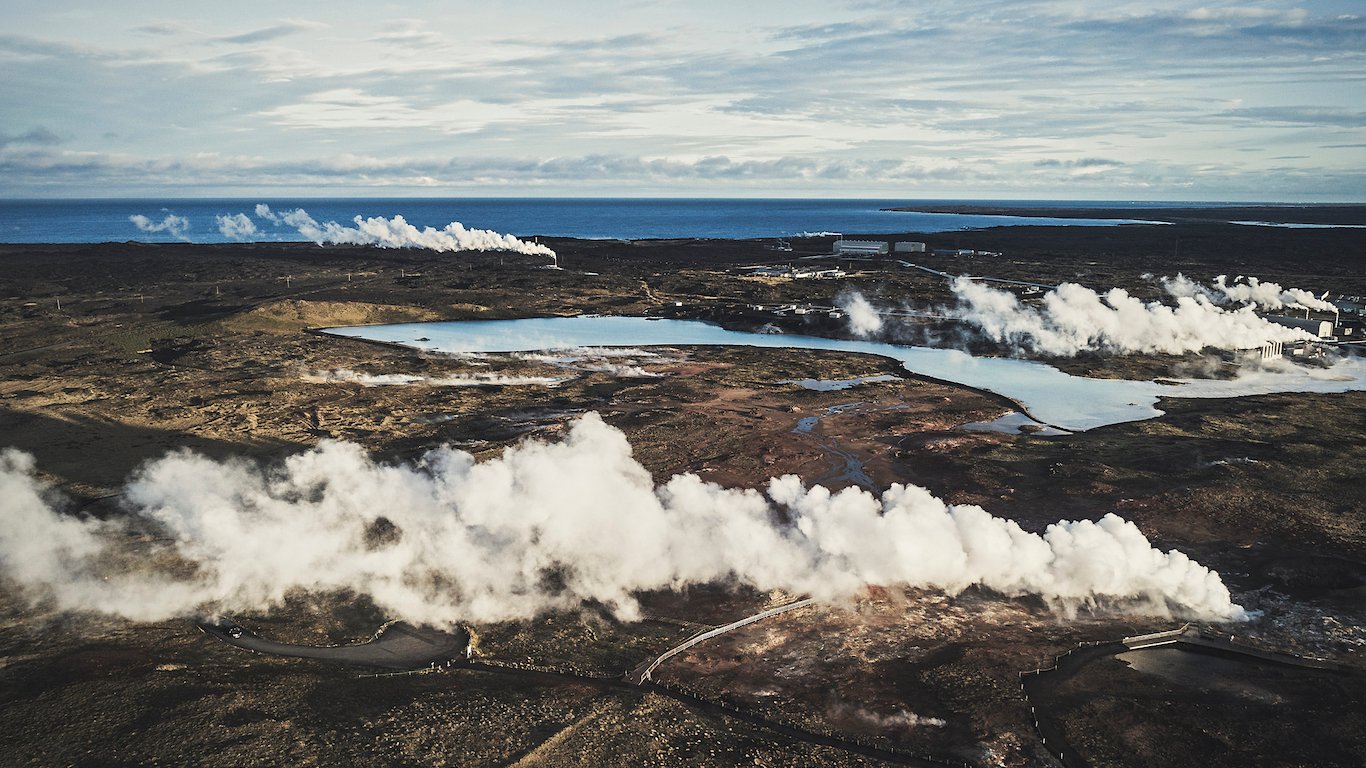
44. Grindavik, Iceland
> Base size: 1,049 acres
> Cost of base: $28.0 million
> Service branch: Navy
> Nearest city: Grindavik
Naval Air Station Keflavik near Grindavik was home to about 5,000 U.S. troops as recently as 2006. That year, the base that had served as a stopover for troops during World War II and the Cold War, was decommissioned. In recent years, however, the Navy decided to renovate a hangar that serves submarine-hunting aircraft in response to increased Russian Navy activity in the North Atlantic. The base is also located about 15 miles from a Naval radio transmitting station in Grindavik.
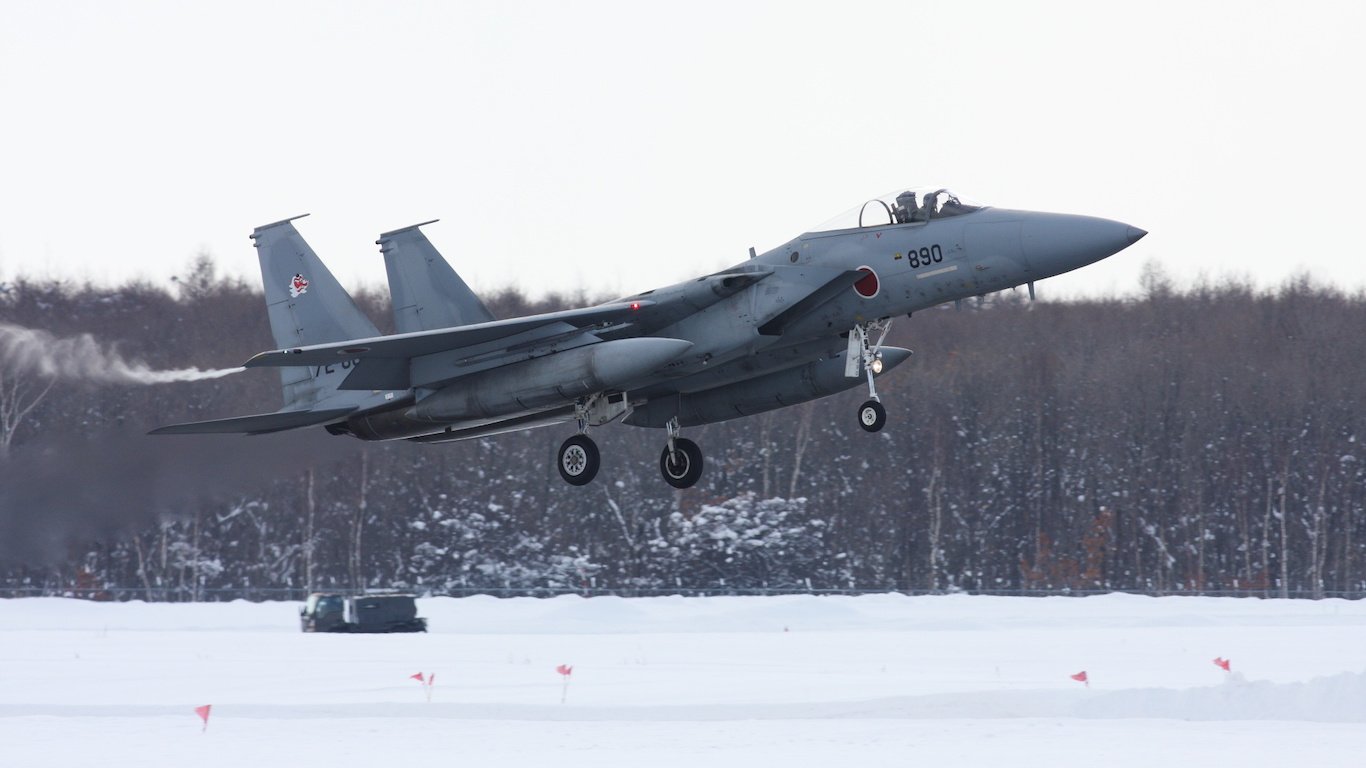
43. Chitose Administration Annex, Japan
> Base size: 1,067 acres
> Cost of base: $57.0 million
> Service branch: Air Force
> Nearest city: Chitose
The Chitose Administration Annex is located on Hokkaido, the northernmost of Japan’s main islands known for its rugged terrain. An air base adjacent to the annex was used by the U.S. Air Force until 1957, when it was turned over to Japan.
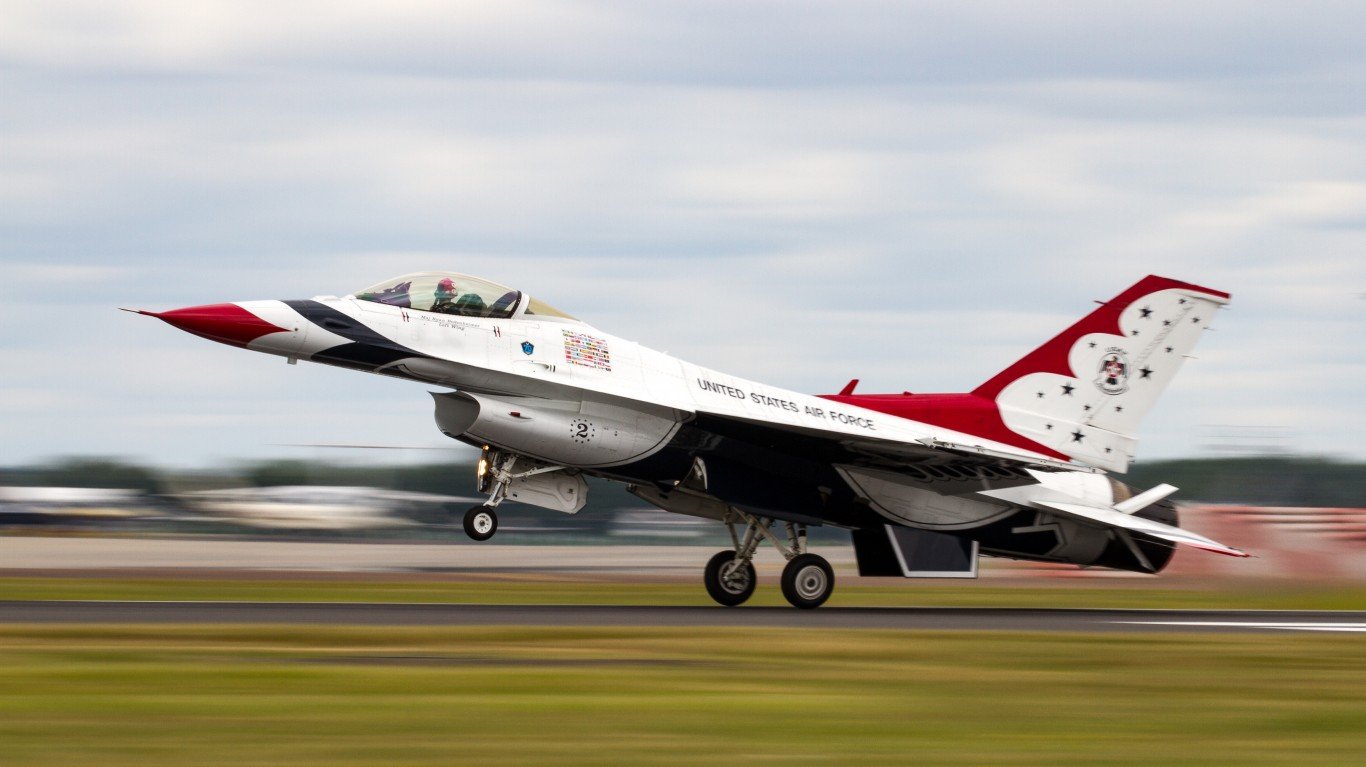
41. RAF Fairford, United Kingdom
> Base size: 1,163 acres
> Cost of base: $772.3 million
> Service branch: Air Force
> Nearest city: Fairford
RAF Fairford is located in Gloucestershire, about 40 miles northwest of Swindon in southern England. RAF Fairford is home to the 420th Air Base Squadron and serves as a primary European location for the U.S. Air Force’s Global Strike Command.
[in-text-ad-2]
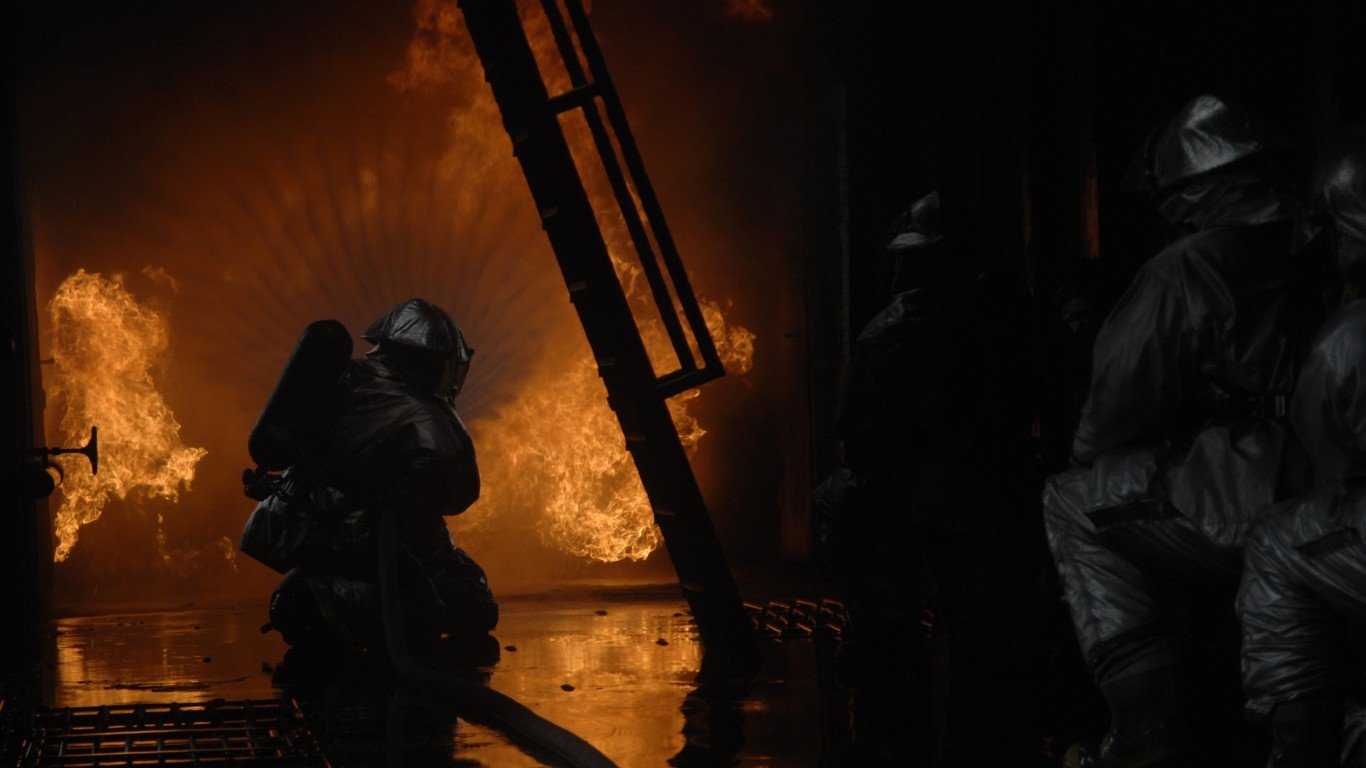
42. RAF Mildenhall, United Kingdom
> Base size: 1,163 acres
> Cost of base: $1.5 billion
> Service branch: Air Force
> Nearest city: Mildenhall
RAF Mildenhall is located in Suffolk in eastern England. The base is among the largest American installations in the U.K. The Royal Air Force began construction of the base in 1934. During World War II, the RAF used base was used for air combat missions. After the war, the base was deactivated until it came under the control of the U.S. military in 1950 as the Cold War escalated.
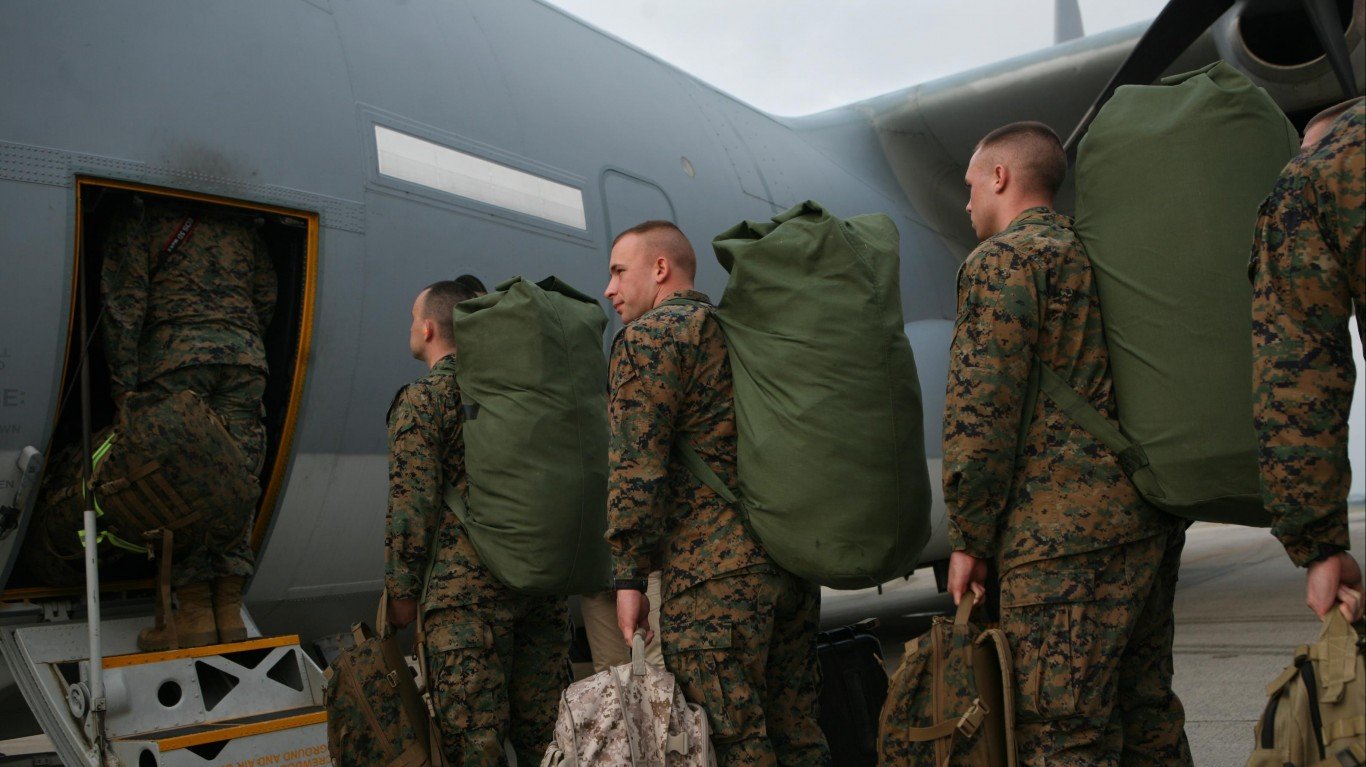
40. Marine Corps Air Station Futenma, Japan
> Base size: 1,177 acres
> Cost of base: $1.7 billion
> Service branch: Marine Corps
> Nearest city: Futenma Okinawa
Marine Corps Air Station at Futenma began as an airfield constructed after the American victory over the Japanese at Okinawa. The base was renamed Futenma Air Base and mostly used in support of adjacent Kadena Air Base, another U.S. installation. In 1957, the Air Force transferred custody of the base to the Marines. Futenma is part of the Camp S.D. Butler complex that comprises 10 installations in Okinawa.
[in-text-ad]
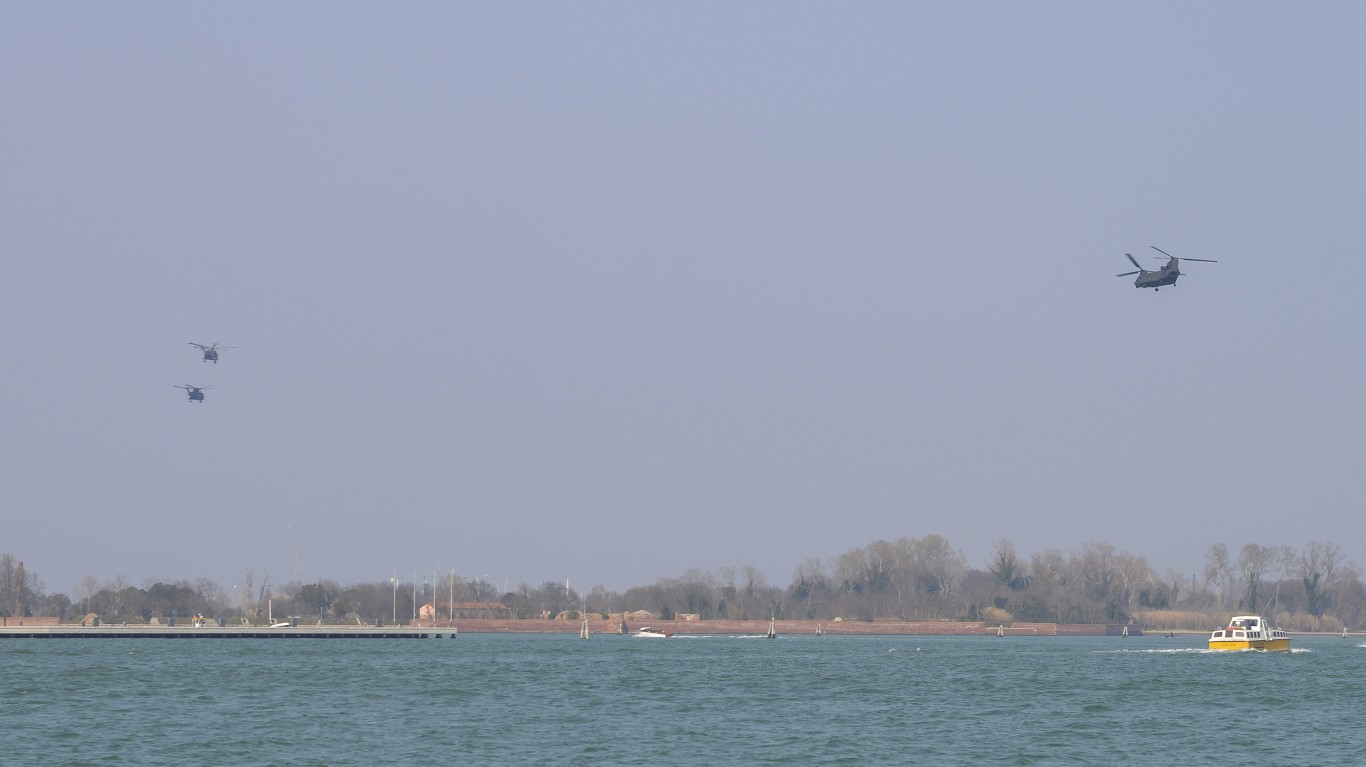
39. Aviano Air Force Base, Italy
> Base size: 1,226 acres
> Cost of base: $1.7 billion
> Service branch: Air Force
> Nearest city: Aviano
The American military presence at Aviano, about 50 miles north of Venice in the Dolomite Mountains, began after World War II. In 1954, the Italian and American governments signed a joint-use agreement, and a year later the base became the headquarters for the U.S. Air Force in Europe.
38. Naval Air Facility Atsugi, Japan
> Base size: 1,237 acres
> Cost of base: $2.8 billion
> Service branch: Navy
> Nearest city: Atsugi
Naval Air Facility Atsugi in Japan is the only U.S. military facility in Asia with an entire air wing unit. The base, built in 1938 by the Japanese Imperial Navy on the island of Honshu, hosts a community of 10,000 people, including American and Japanese military personnel. Because of its strategic importance, facilities, and logistic services, this base is considered to be the “Tip of the Sword” of American security forces in the Western Pacific.

37. Camp Foster, Japan
> Base size: 1,347 acres
> Cost of base: $5.3 billion
> Service branch: Marine Corps
> Nearest city: Zukeran
Camp Foster, located on Okinawa Island, is part of a complex of military installations that were developed after the United States defeated Japan in World War II. The facility was originally called Camp Zukeran, but changed its name to Camp Foster in honor of PFC William A. Foster, who won the Medal of Honor for flying perilous missions over Okinawa during the battle for the island. The camp had been the center of Marine Corps operations on Okinawa but its presence has diminished as the U.S. has consolidated military facilities on the island.
[in-text-ad-2]

36. Osan Air Force Base, South Korea
> Base size: 1,523 acres
> Cost of base: $3.5 billion
> Service branch: Air Force
> Nearest city: Gyeonggi-do
Osan Air Force Base, one of several active Air Force facilities operated by the U.S. military in South Korea, is located 40 miles from Seoul. The United States built the base from the ground up in 1953 up after capturing the area from communist troops. Osan Air Force Base hosts the 51st Fighter Wing.
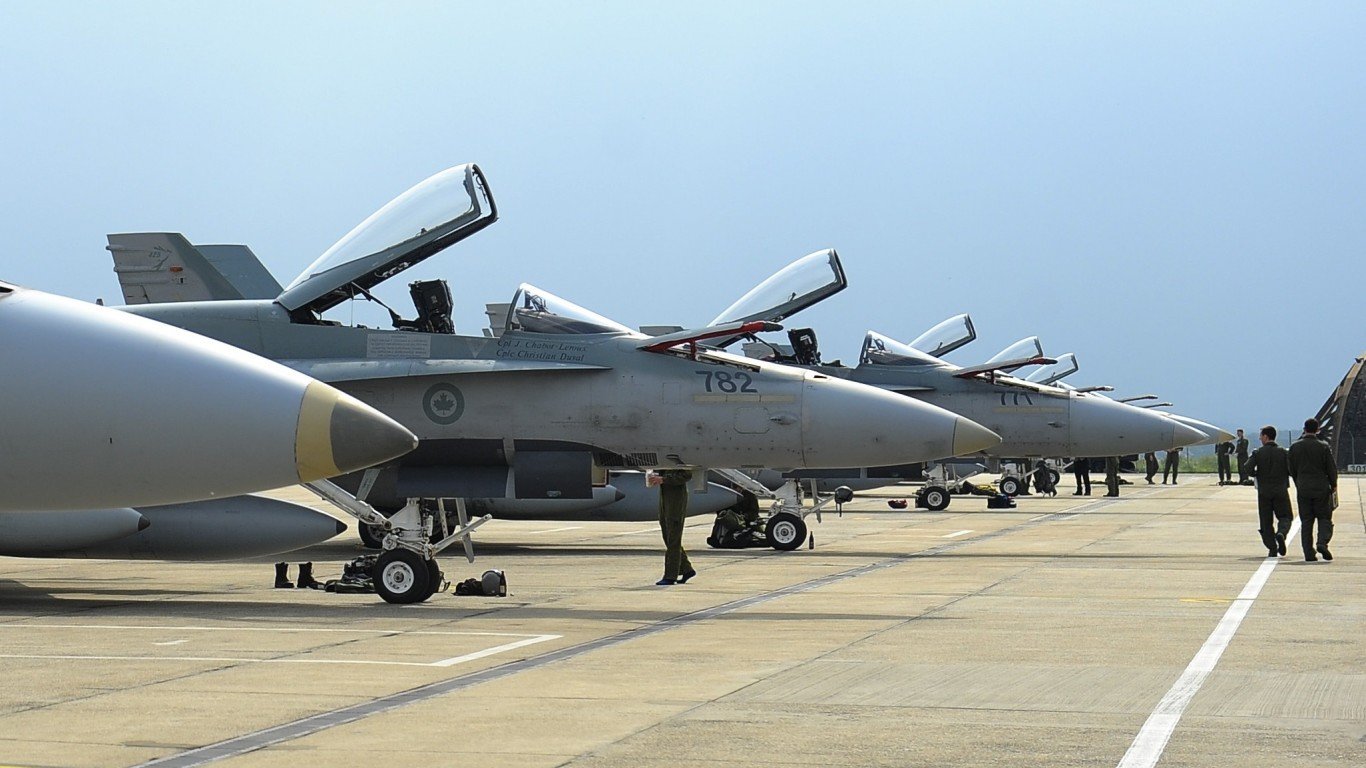
35. Spangdahlem Air Base, Germany
> Base size: 1,617 acres
> Cost of base: $2.1 billion
> Service branch: Air Force
> Nearest city: Spangdahlem
Spangdahlem Air Base has been a U.S. Air Force facility for more than 50 years. The installation is in western Germany, near the borders of Belgium, Luxembourg, and France. Spangdahlem Air Base hosts the 52nd Fighter Wing.
[in-text-ad]
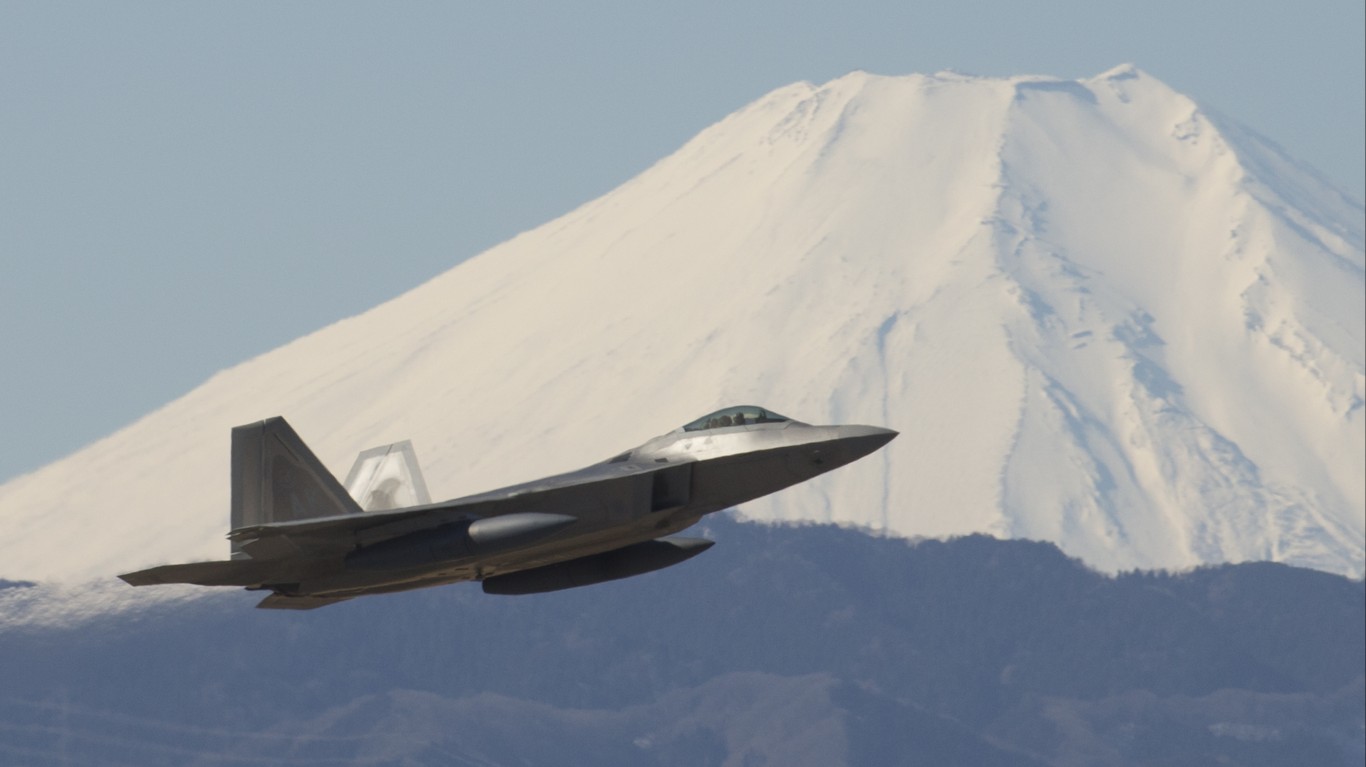
34. Yokota Air Base, Japan
> Base size: 1,750 acres
> Cost of base: $6.8 billion
> Service branch: Air Force
> Nearest city: Tokyo
The Yokota Air Base, opened in 1940 as a test facility for the Japanese Imperial Army, became an air base during World War II. The 374th Air Wing located there after the U.S. military took over the base and the unit was among the first to fight in Korea in 1950. Yokota, located on the island of Honshu, is a primary airlift wing in the Western Pacific. Every year in August, the base hosts a two-day Friendship Festival and invites the Japanese community to come to the base and learn about it.
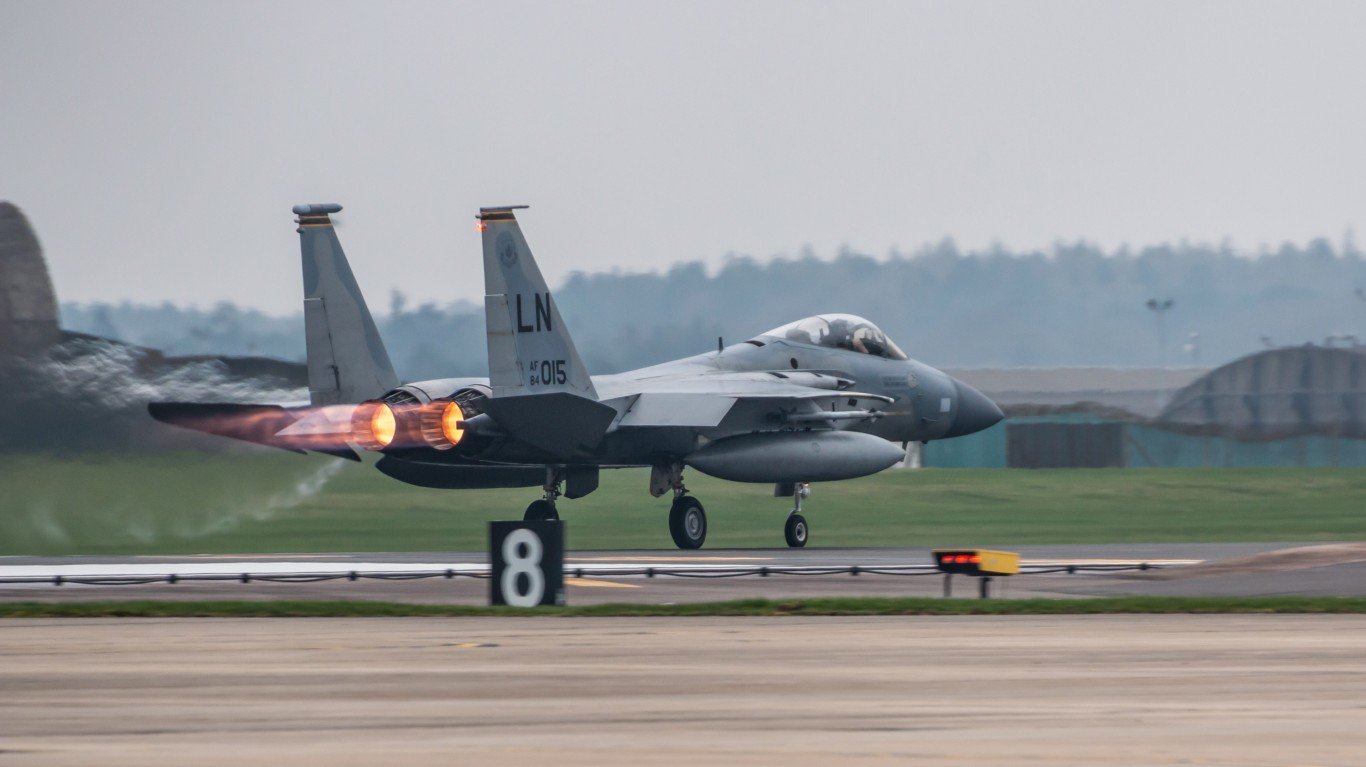
33. RAF Lakenheath, United Kingdom
> Base size: 1,879 acres
> Cost of base: $2.9 billion
> Service branch: Air Force
> Nearest city: Lakenheath
RAF Lakenheath is located in Suffolk in the eastern region of England. It is the largest U.S. Air Force-operated base in England. The base traces its roots back to World War I. It was abandoned once the war was over, but as the threat of Nazi invasion rose in 1940, the facility was made to look like a functioning airfield to try and fool the German Luftwaffe and keep them from attacking the nearby RAF Mildenhall. The RAF eventually converted it into an operational facility, and the Americans took it over after the war and used it for operations during the Cold War.
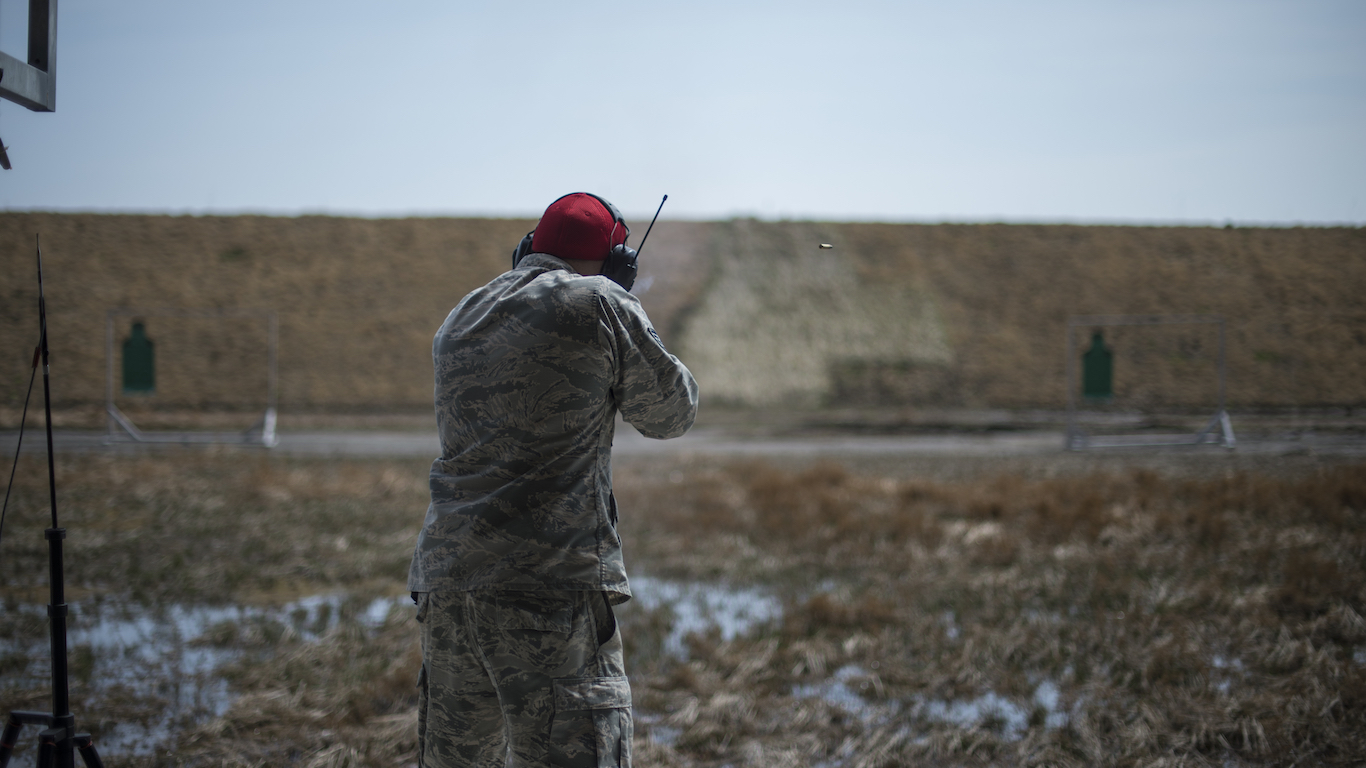
32. Draughon Training Range, Japan
> Base size: 1,889 acres
> Cost of base: $36.0 million
> Service branch: Air Force
> Nearest city: Misawa
Draughon Training Range is a desolate area in northern Japan that encompasses almost 1,900 acres and is not far from Misawa Air Force Base. Air Force and Navy pilots have been training at this facility since the Vietnam War, and their mission is the suppression of enemy air defenses, or SEAD. The base’s strategic location puts aircraft in position to meet challenges from North Korea.
[in-text-ad-2]
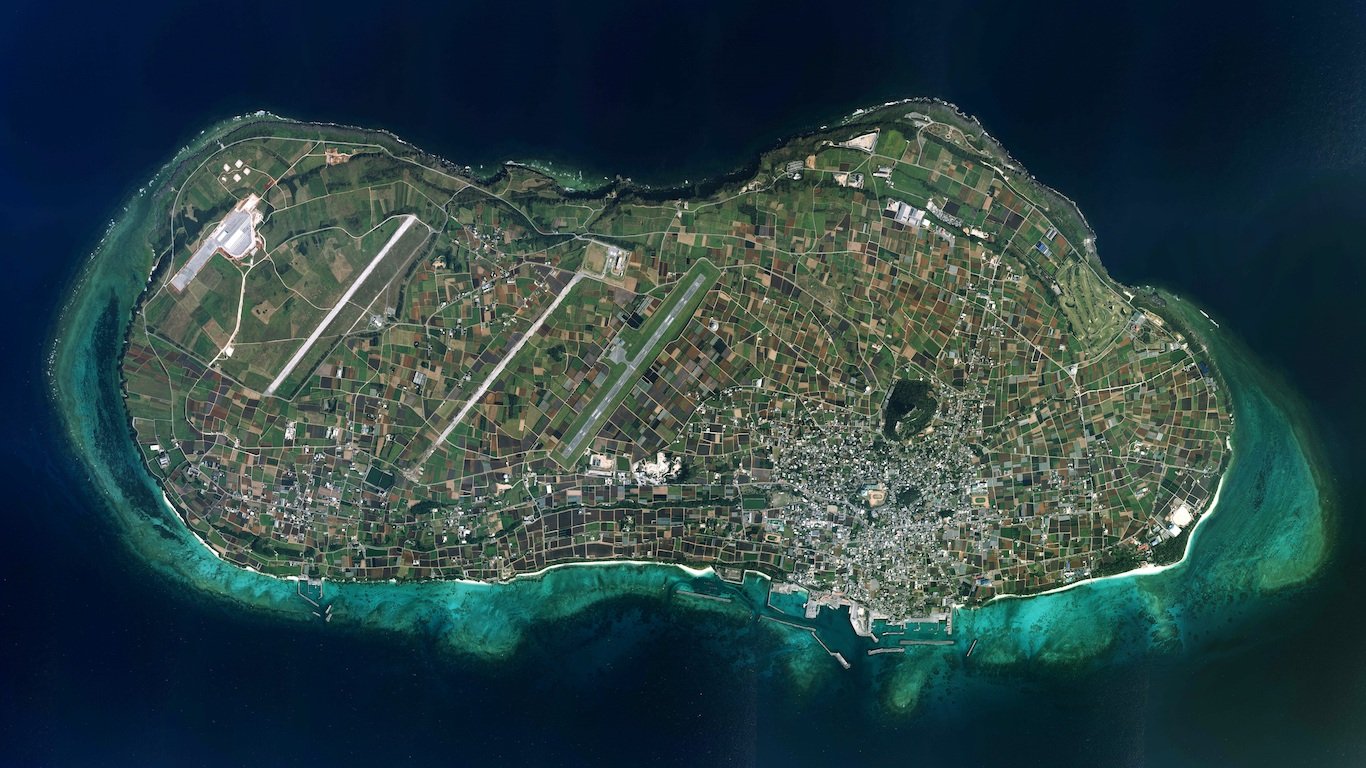
31. IE Jima Aux Airfield, Japan
> Base size: 1,981 acres
> Cost of base: $95.2 million
> Service branch: Marine Corps
> Nearest city: Henoko Okinawa
Ie Jima Auxiliary Airfield takes up one-third of the small island Ie Jima, which is 3 miles west of Okinawa. The facility was built by Japan during World War II and taken over by the United States at the end of the war. Ie Jima is where the noted military correspondent Ernie Pyle was killed in action. The Marines use the base for training exercises such as parachute drops and Harrier aircraft landing exercises.
30. Camp Humphreys, South Korea
> Base size: 2,121 acres
> Cost of base: $5.6 billion
> Service branch: Army
> Nearest city: Pyeongtaek
Camp Humphreys, or U.S. Army Garrison Humphreys, is located 40 miles south of Seoul, South Korea. It was created by the Japanese in 1919 during their occupation of the Korean Peninsula. After World War II, the Americans took over the base, and it was used by the U.S. Air Force during the Korean War. The United States is in the process of consolidating military presence in Korea into two hubs, the largest of which will be Camp Humphreys, tripling in size to 36,000 soldiers, family members, and civilians.
[in-text-ad]
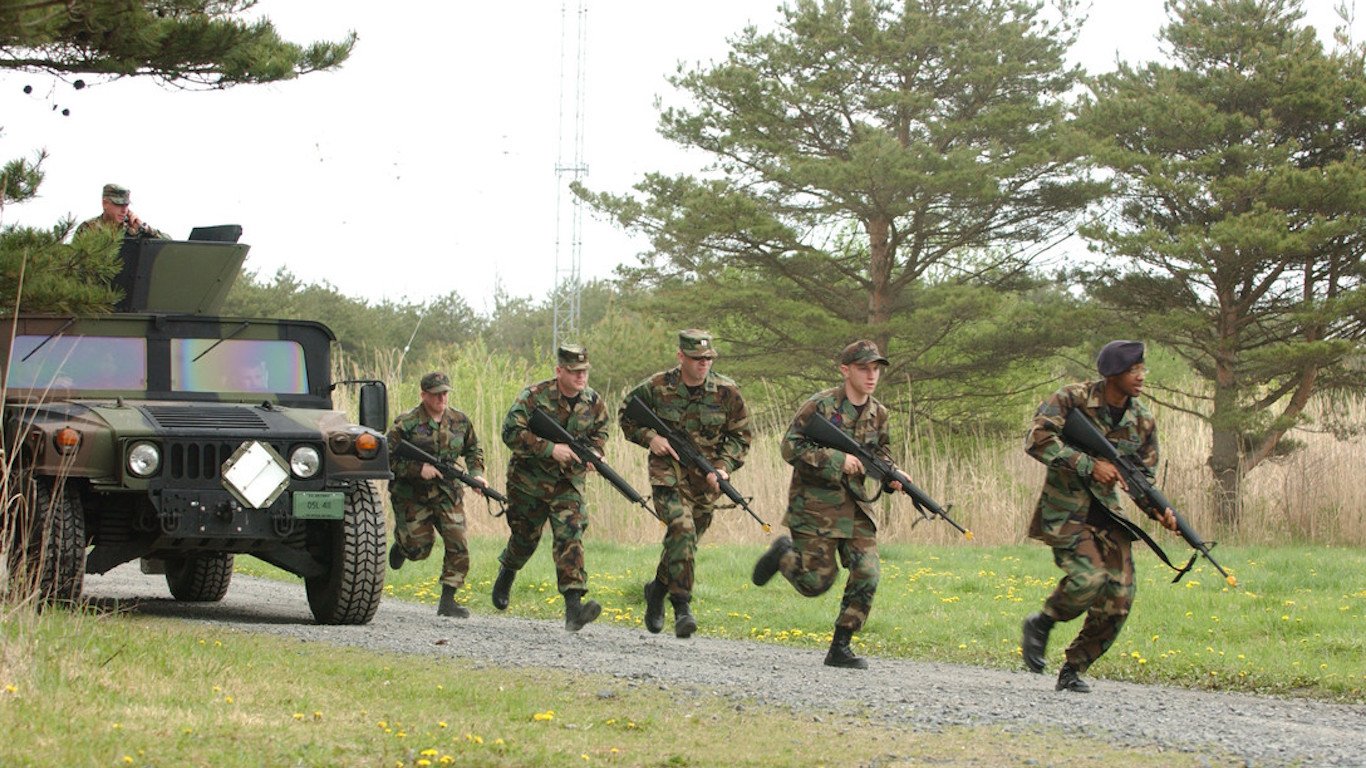
29. Camp Red Cloud (Bullseye 01), South Korea
> Base size: 2,204 acres
> Cost of base: $140.0 million
> Service branch: Army
> Nearest city: Yongchon
Camp Red Cloud, where U.S. troops had been deployed since the Korean War, closed in October 2018 as part of an ongoing military base consolidation program in South Korea. The camp has been targeted for closure since a 2004 agreement to trim the American military presence north of the Han River. Most American military personnel are stationed around the South Korean capital of Seoul and the heavily fortified bases near the Demilitarized Zone. The relocation was supposed to be completed by 2008 but was delayed because of construction issues at Camp Humphreys, which is increasing in size. Camp Red Cloud was named after Medal of Honor recipient Cpl. Mitchell Red Cloud Jr.

28. Kunsan Air Base, South Korea
> Base size: 2,549 acres
> Cost of base: $2.3 billion
> Service branch: Air Force
> Nearest city: Kunsan
Kunsan Air Base is one of several U.S. Air Force installations in South Korea and home of the 8th Fighter Wing. It is located 150 miles south of Seoul on the western side of the peninsula. The Japanese built the base in 1938, and the base became strategically important during the Korean War for missions against Chinese and North Korean positions.

27. Commander Fleet Activities Yokosuka, Japan
> Base size: 2,704 acres
> Cost of base: $10.2 billion
> Service branch: Navy
> Nearest city: Yokosuka
The facility known as CFAY, for Commander Fleet Activities Yokosuka, is the largest and most important U.S. naval base in Asia — it is home of the 7th Fleet. The base is located 30 miles southwest of Tokyo and at the mouth of Tokyo Bay. It was built by Japan in 1871 to accommodate its growing trade in the 19th century, and the base is among the oldest of the overseas facilities of the United States.
[in-text-ad-2]
26. Camp Casey, South Korea
> Base size: 2,830 acres
> Cost of base: $1.6 billion
> Service branch: Army
> Nearest city: Tong Du Chon
Camp Casey sits in between the South Korean capital of Seoul and the Demilitarized Zone. Elements of the 2nd Infantry Division and the 210th Field Artillery Brigade are stationed at Camp Casey, which houses about 6,300 military personnel and about 2,500 civilians. At Camp Casey, U.S. and South Korean forces are integrated, a process that is occurring at other bases in South Korea.
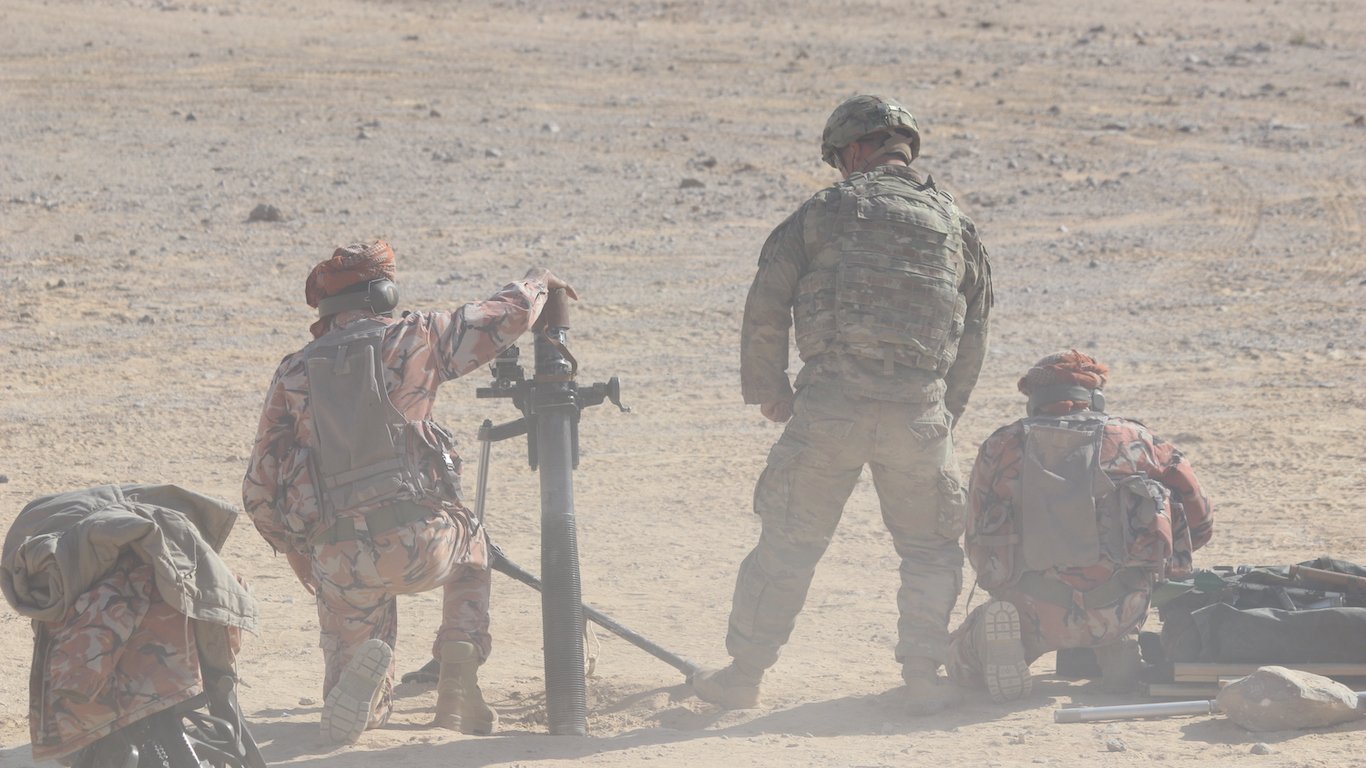
25. Thumrait Air Base, Oman
> Base size: 3,000 acres
> Cost of base: N/A
> Service branch: Air Force Muscat
> Nearest city: N/A
The U.S. signed an access agreement for use of the Thumrait base with Oman in 1981. It is one of three Air Force sites that support equipment and materiel needs for 26,000 military personnel in the small Persian Gulf nation. Thumrait is what the Air Force calls a Harvest Falcon depot that provides transportable tents, shelters, equipment, and vehicles.
[in-text-ad]
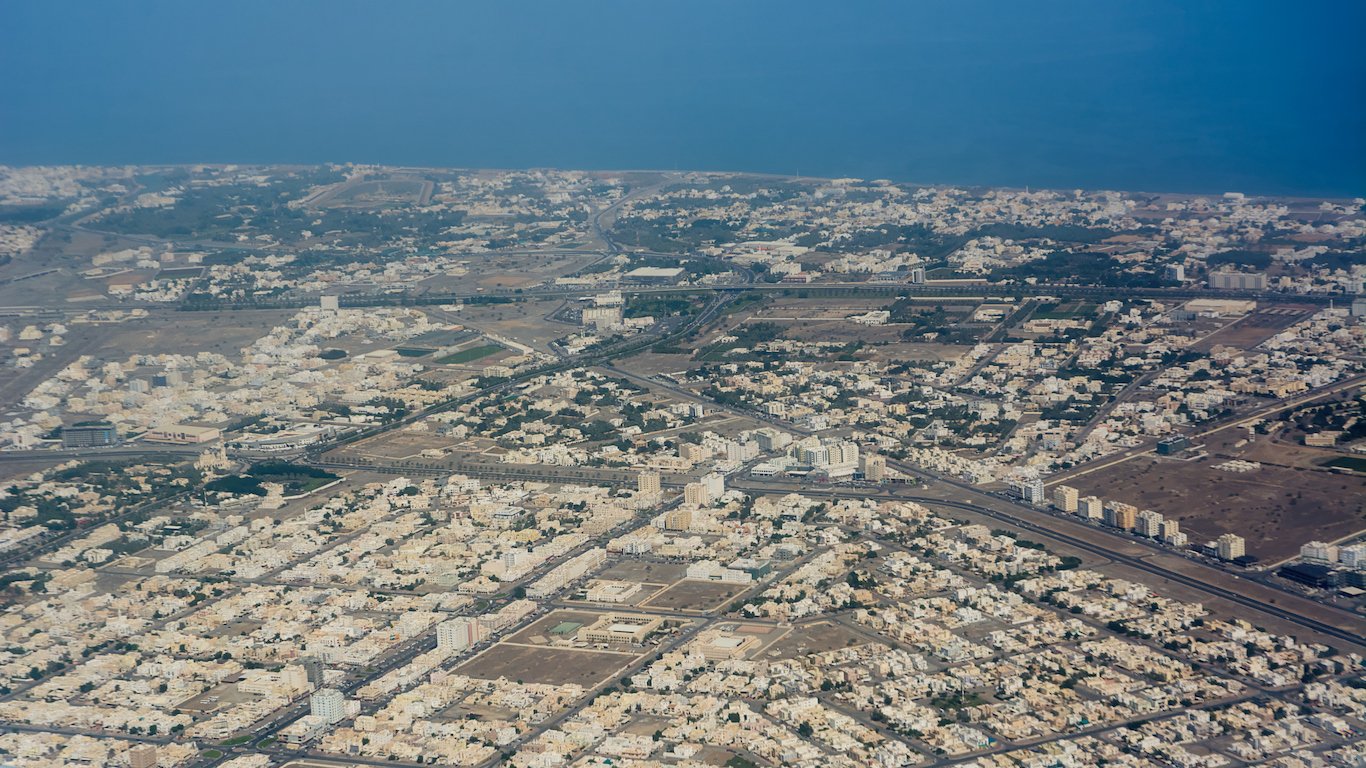
24. SEEB MPT Site 1, Oman
> Base size: 3,000 acres
> Cost of base: $175.8 million
> Service branch: Air Force Muscat
> Nearest city: N/A
The base operates at Muscat International Airport in Oman and features two runways that have been extended to 13,123 feet. Military equipment is stored at that location. The base was part of the access agreement between the United States and Oman for use of one of several military sites in Oman that support equipment and materiel needs for U.S.military personnel.
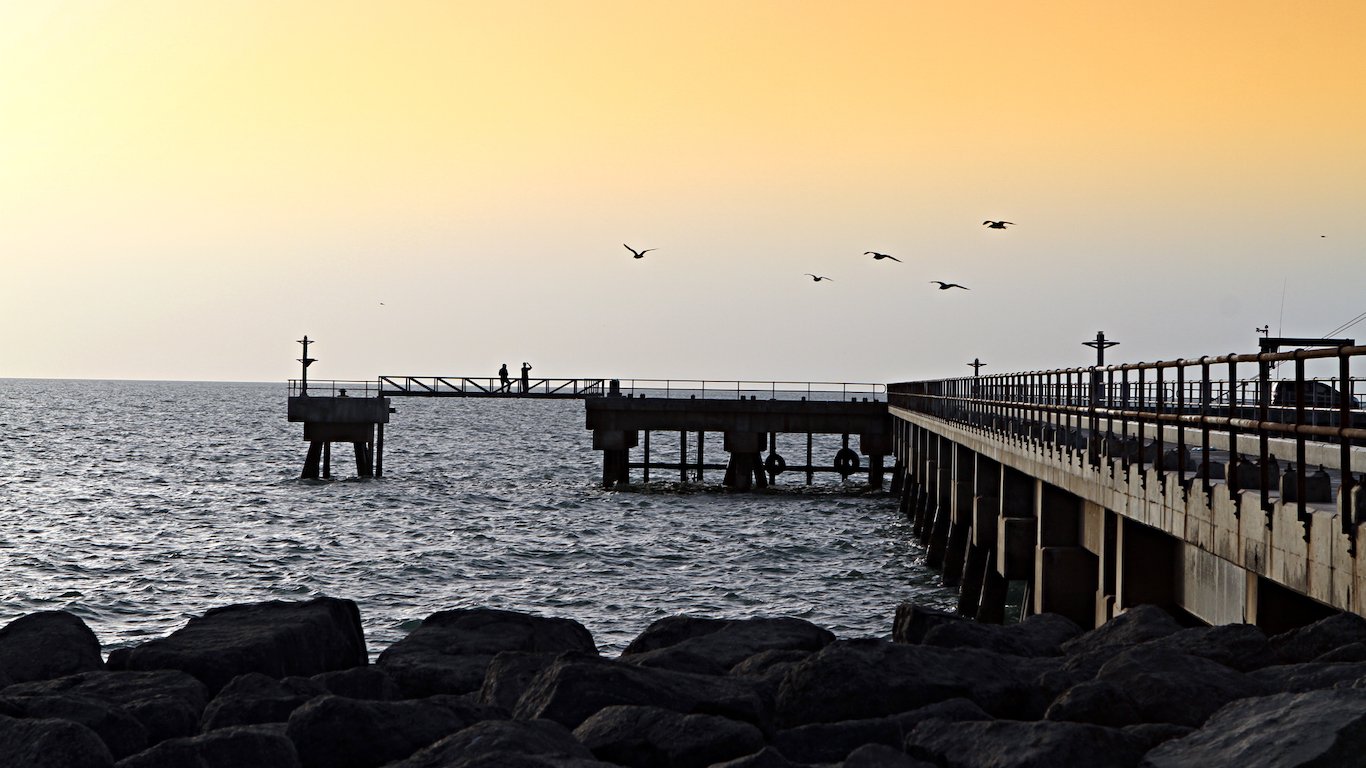
23. Masirah Island Mpt Site 1, Oman
> Base size: 3,000 acres
> Cost of base: N/A
> Service branch: Air Force Muscat
> Nearest city: N/A
The island base is located 15 miles off the coast of Oman. It originally belonged to the Royal Air Force before it was taken over by the United States in 1980 in an agreement with Oman. The U.S. Air Force built up the facilities, and the base became crucial during Operation Desert Shield in 1990.
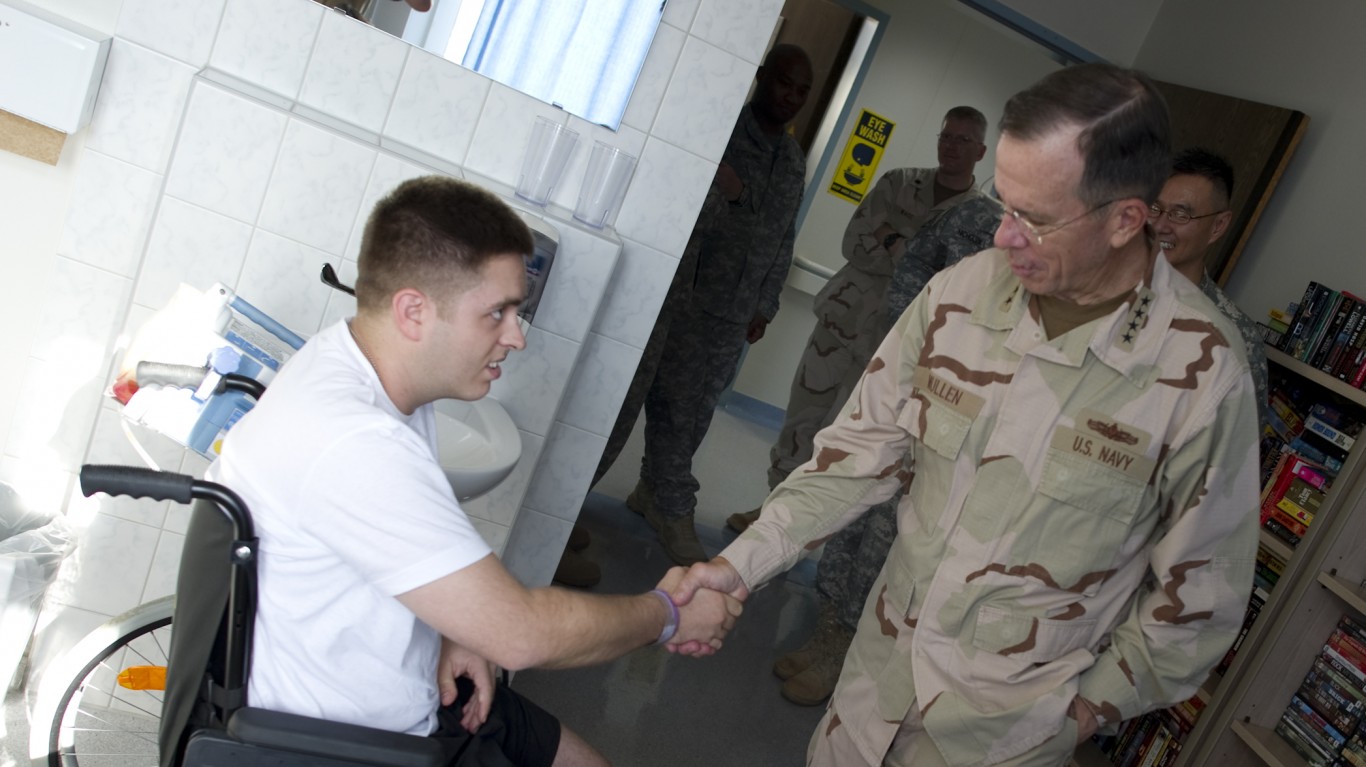
22. Ramstein Air Base, Germany
> Base size: 3,094 acres
> Cost of base: $12.6 billion
> Service branch: Air Force
> Nearest city: Ramstein
Ramstein was built in 1951 out of a swamp in western Germany near the French border. Ramstein hosts the 86th airlift unit. The area is also called “little America” because of the 50,000 U.S. personnel who reside in the region. Ramstein, as well as other U.S. bases in Germany, has been the site of protestors who want the United States to close military bases in Germany. In 1988, Italian stunt planes collided and crashed during an air show at Ramstein. The collisions killed 70 people.
[in-text-ad-2]

21. Incirlik Air Base, Turkey
> Base size: 3,336 acres
> Cost of base: $2.5 billion
> Service branch: Air Force
> Nearest city: Adana
Since it opened in 1951, Incirlik Air Base has been jointly operated by the United States and Turkey. Because of its relative proximity to Russia, the base, where 5,000 military personnel are stationed, are considered strategically important. In recent years, the United States has used Turkish bases to launch strikes against terror groups like ISIS in Syria and Iraq. Recent disagreements between the United States and Turkey have led the U.S. to reconsider its military presence in the strategically important nation.

20. Yong Pyong, South Korea
> Base size: 3,346 acres
> Cost of base: $501.5 million
> Service branch: Army
> Nearest city: Tong Du Chon
The base is located in the rural Yong Pyong region in northern South Korea. It is a training center for armored units to conduct gunnery training, often using live fire. Units of the 2nd Infantry Division use the facility for training in helicopter, Bradley Fighting Vehicle, M1 Abrams tank, artillery, and close air support.
[in-text-ad]
19. Morón Air Base, Spain
> Base size: 3,428 acres
> Cost of base: $829.1 million
> Service branch: Air Force
> Nearest city: Moron de la Frontera
Morón Air Base, located in the Andalusia region in southern Spain, is home to the 496th Air Base Squadron. The U.S. military stations about 3,000 people at the base, which has been used for operations against Libya as well as assistance in the humanitarian crisis of North African refugees. Morón Air Base hosts units of the Air Mobility Command, Air Force Space Command, and Air Force Office of Special Investigations.

18. Ascension Auxiliary Airfield, Saint Helena
> Base size: 3,463 acres
> Cost of base: $714.9 million
> Service branch: Air Force
> Nearest city: Ascension Island
Ascension Island in the South Atlantic was originally used as a base by the Royal Navy to interdict the slave trade. Ascension Island took on greater importance during World War II, when the British allowed the United States to build an airstrip there that would become Ascension Auxiliary Airfield. American planes landed there from Brazil and continued north through Africa. The U.S. military augmented the facilities during the Cold War, and the base was used to launch research rockets to track Apollo missions.
17. Misawa Air Base, Japan
> Base size: 3,864 acres
> Cost of base: $8.3 billion
> Service branch: Air Force
> Nearest city: Misawa
Misawa Air Base, about 400 miles north of Tokyo on Honshu Island, is important in Japanese military history. It was here that pilots trained for the attack on Pearl Harbor and where the Japanese Empire trained kamikaze pilots. About 90% of the base was destroyed by Allied bombing during World War II. Today, the base combines military personnel from the United States and Japan. Among the objectives of the base is space surveillance through the use of satellites. The base is home to the 35th Fighter Wing.
[in-text-ad-2]
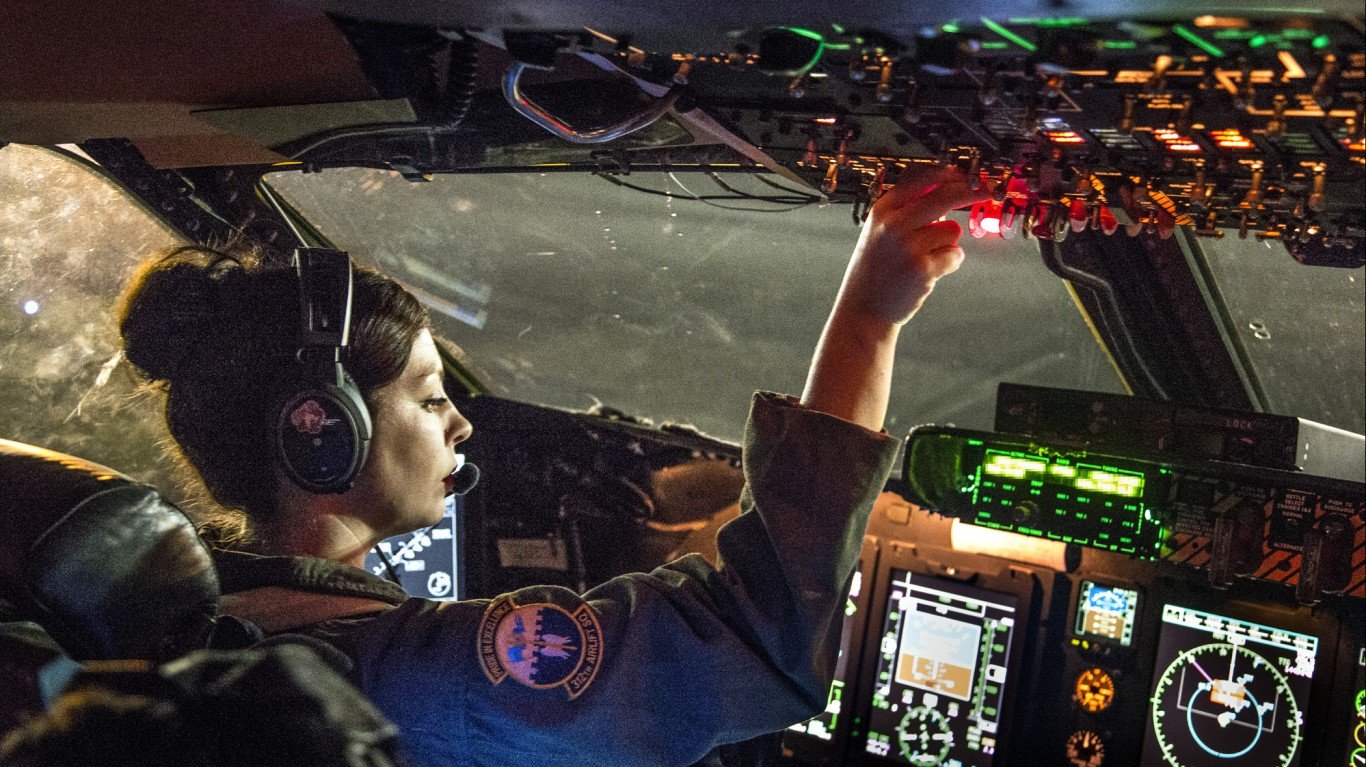
16. Kadena Air Base, Japan
> Base size: 4,906 acres
> Cost of base: $12.3 billion
> Service branch: Air Force
> Nearest city: Okinawa
The Kadena Air Base located in Okinawa City, Okinawa, Japan, is anchored by the 18th Wing, a fleet of 81 combat-ready aircraft that constitutes one of the largest operational combat wings overseas. Kadena is home to about 8,000 American air personnel. The United States captured the airstrip from Japan hours into the battle for Okinawa, repaired the damaged runway, and made it operational days later.
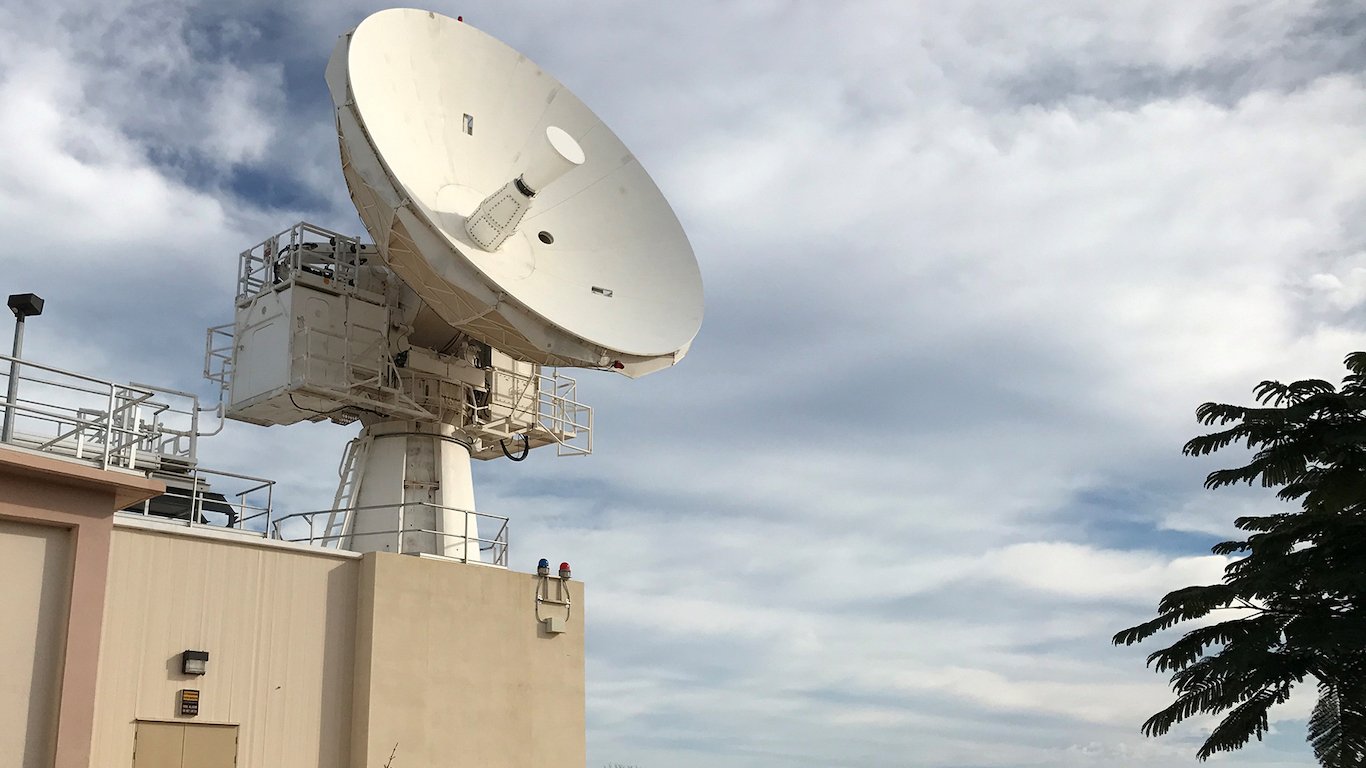
15. Naval Communication Station Harold E. Holt, Exmouth, Australia
> Base size: 5,099 acres
> Cost of base: $254.7 million
> Service branch: Navy
> Nearest city: Northwest Cape
The Naval Communication Station Harold E. Holt in western Australia, a joint operation of the United States and Australia, comprises three sites about 37 miles apart located on a peninsula that separates the Exmouth Gulf from the Indian Ocean. The station was set up in 1967 and intended to provide the Navy with the ability to communicate with submarines and surface vessels in the Indian and western Pacific Oceans. Plans call for the station to be used for space surveillance and global military intelligence.
[in-text-ad]
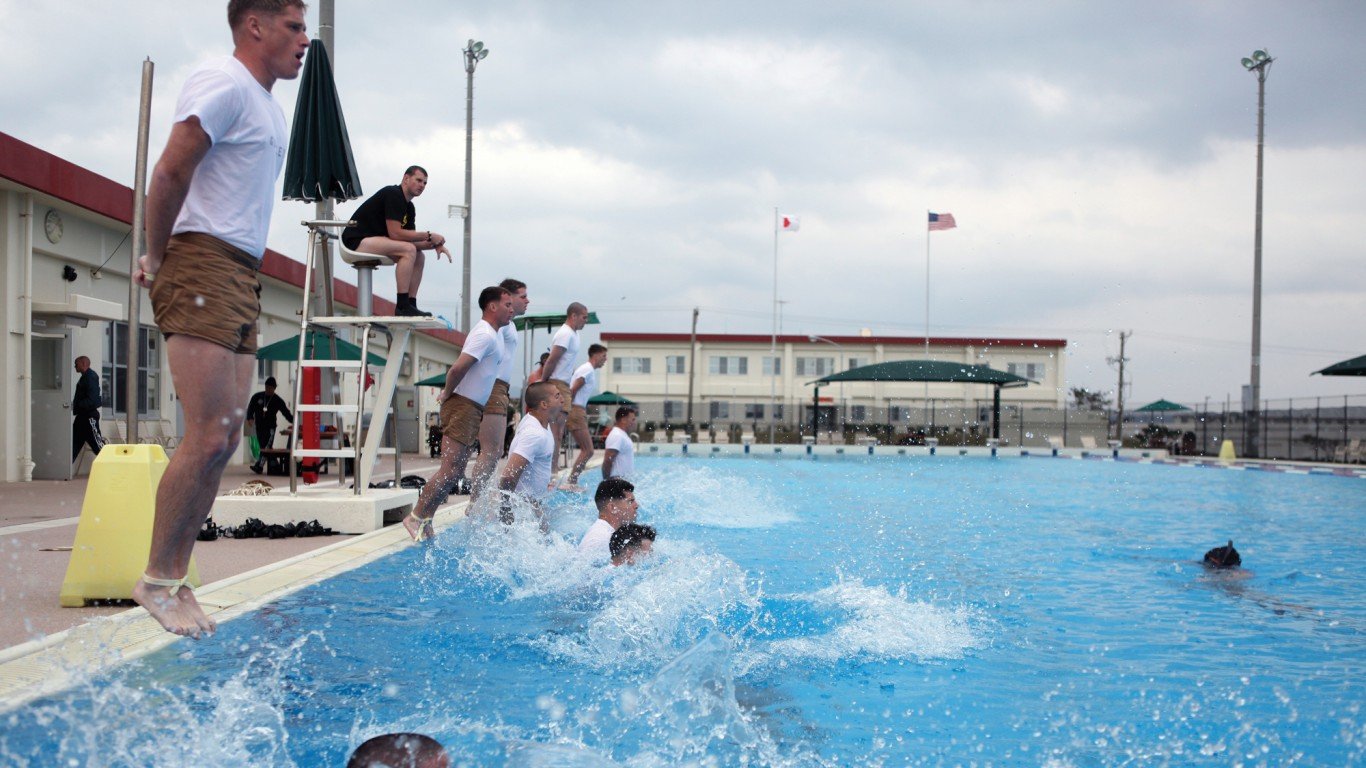
14. Camp Schwab, Japan
> Base size: 5,397 acres
> Cost of base: $1.6 billion
> Service branch: Marine Corps
> Nearest city: Henoko Okinawa
Camp Schwab is a U.S. military base on the island of Okinawa. It was named in memory of PFC Albert E. Schwab, a Marine who won the Medal of Honor for bravery during the Battle of Okinawa in 1945. It became a permanent military facility in 1959 and serves as a training range for the troops stationed on the island.

13. Area A-VLF, Australia
> Base size: 5,510 acres
> Cost of base: N/A
> Service branch: Navy
> Nearest city: Exmouth
Area A-VLF is a very low frequency communications facility located at the North West Cape in western Australia on a peninsula that separates the Indian Ocean from the Exmouth Gulf. The VLF transmitter is part of a joint American-Australian communications network that communicates with surface ships and submarines.
12. Naval Station Rota, Spain
> Base size: 5,962 acres
> Cost of base: $2.0 billion
> Service branch: Navy
> Nearest city: Rota
Naval Station Rota, located in southern Spain, was established in 1953. It provides logistical support and serves as a strategic presence in the eastern Mediterranean Sea. It supports U.S. naval forces in Europe and Africa that include the 6th Fleet at a nearly 6,000-acre facility. The base also includes a 670-acre airfield and the biggest fuels and weapons facilities in Europe. Rota is home to more than 3,000 Navy sailors, Marines, and their families. The base also has smaller Army and Air Force attachments.
[in-text-ad-2]
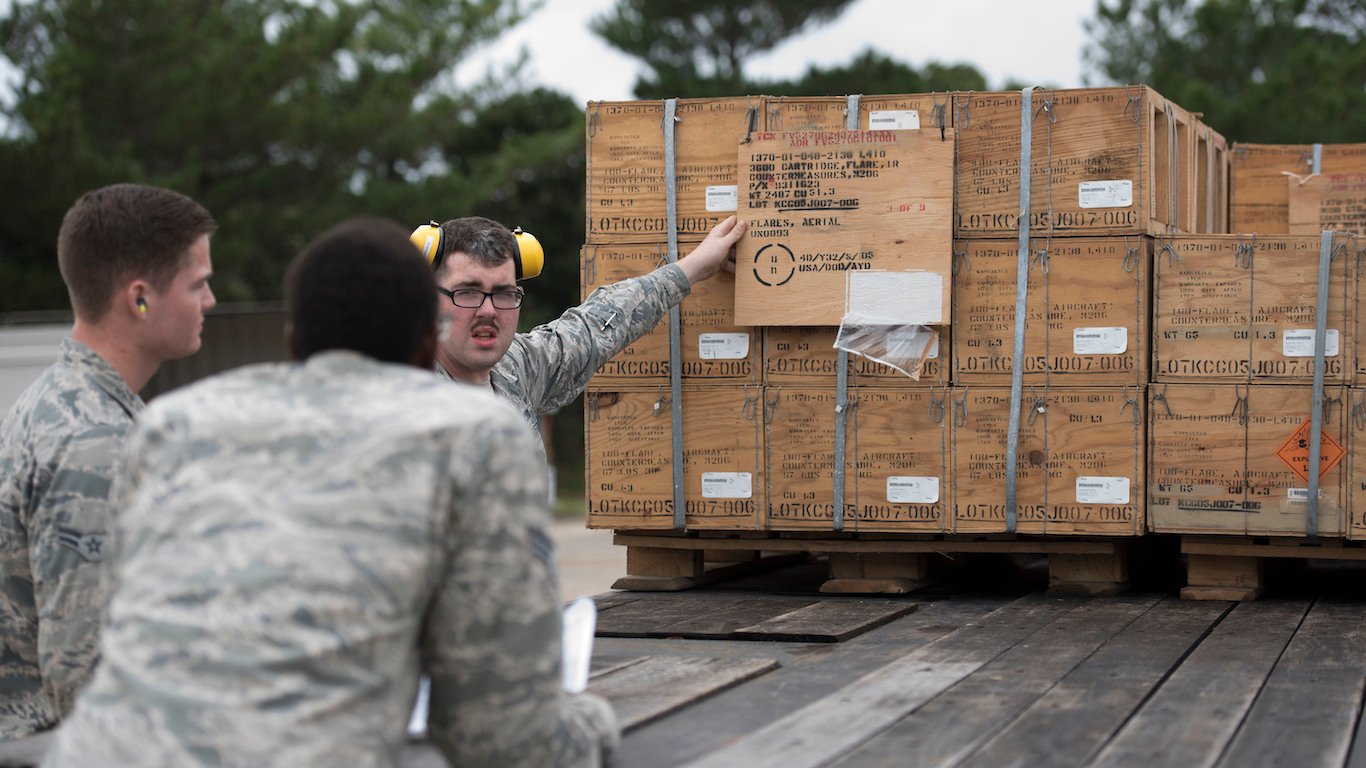
11. Kadena Ammo Storage Annex, Japan
> Base size: 6,077 acres
> Cost of base: $1.5 billion
> Service branch: Air Force
> Nearest city: Okinawa
The ammunition depot adjacent to Kadena Air Base at Chibana in Japan once stored one of the largest arsenals of lethal weapons on the planet. Included in the depot were nuclear warheads, herbicides, and sarin gas. Chemical weapons leaked from the depot on two occasions in the late 1960s and early 1970s, hospitalizing 27 Americans.
10. Naval Support Facility Diego Garcia, Diego Garcia
> Base size: 7,000 acres
> Cost of base: $4.5 billion
> Service branch: Navy
> Nearest city: Diego Garcia
Diego Garcia, which is home to a naval support facility, is a speck in the Indian Ocean, an atoll of the Chagos Archipelago located just south of the equator. The base provides service, installation, and logistic support for American and NATO vessels and aircraft deployed in the Indian Ocean and Arabian Gulf regions. The United States and Great Britain signed a formal agreement in 1966 to use Diego Garcia for mutual defense needs.
[in-text-ad]
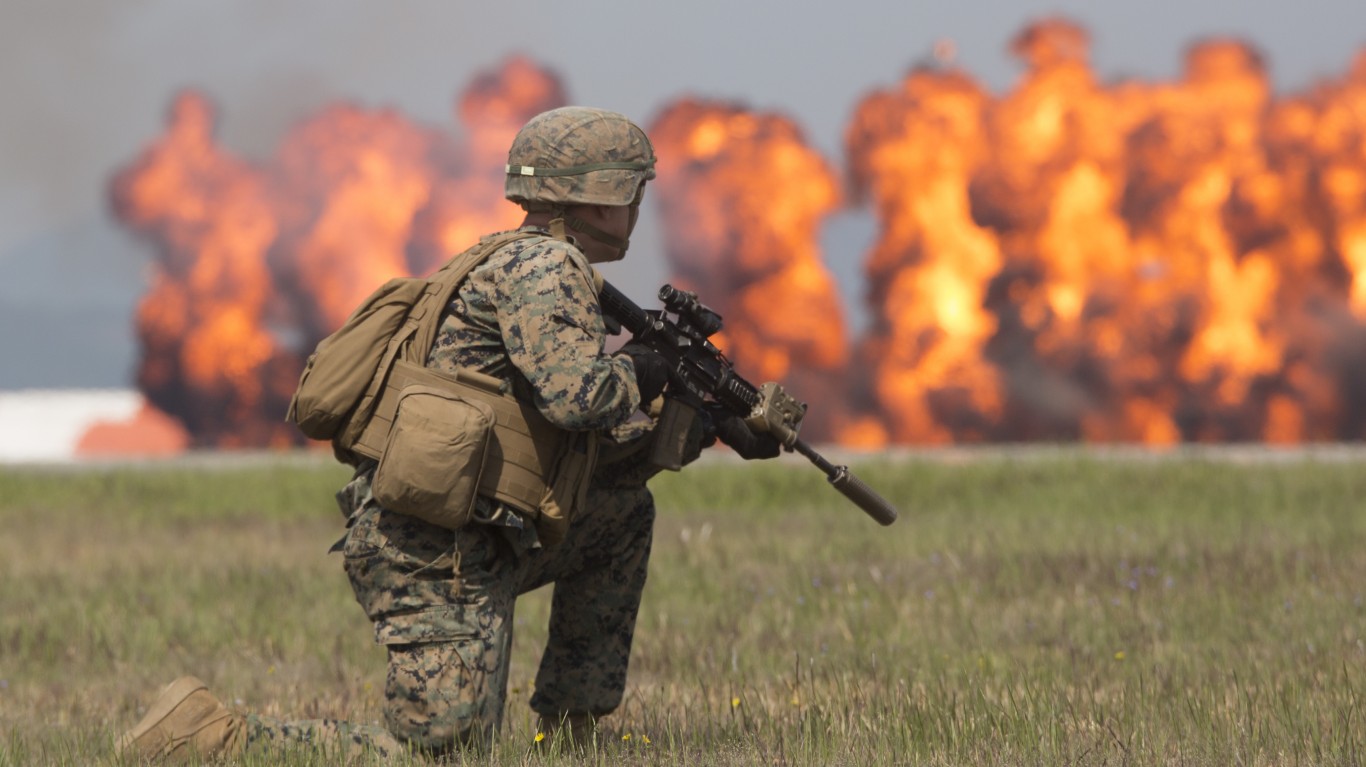
9. Marine Corps Air Station Iwakuni, Japan
> Base size: 7,111 acres
> Cost of base: $7.2 billion
> Service branch: Marine Corps
> Nearest city: Iwakuni
Marine Corps Air Station Iwakuni, Japan, is located about 600 miles southwest of Tokyo on the island of Honshu. The base hosts about half of the 1st Marine Aircraft Wing, which is headquartered on Okinawa, as well as other Marine group elements. There are about 15,000 personnel, including U.S. Marines and Japanese national employees, at the station.
Like many of the U.S. bases in Japan, the facility has its roots with the Japanese Empire, which developed the farmland as an air station at the outset of World War II. After the war, the base came under the command of the Royal Australian Air Force, then passed to several branches of the U.S. military until the Marines took over the facility in 1958.
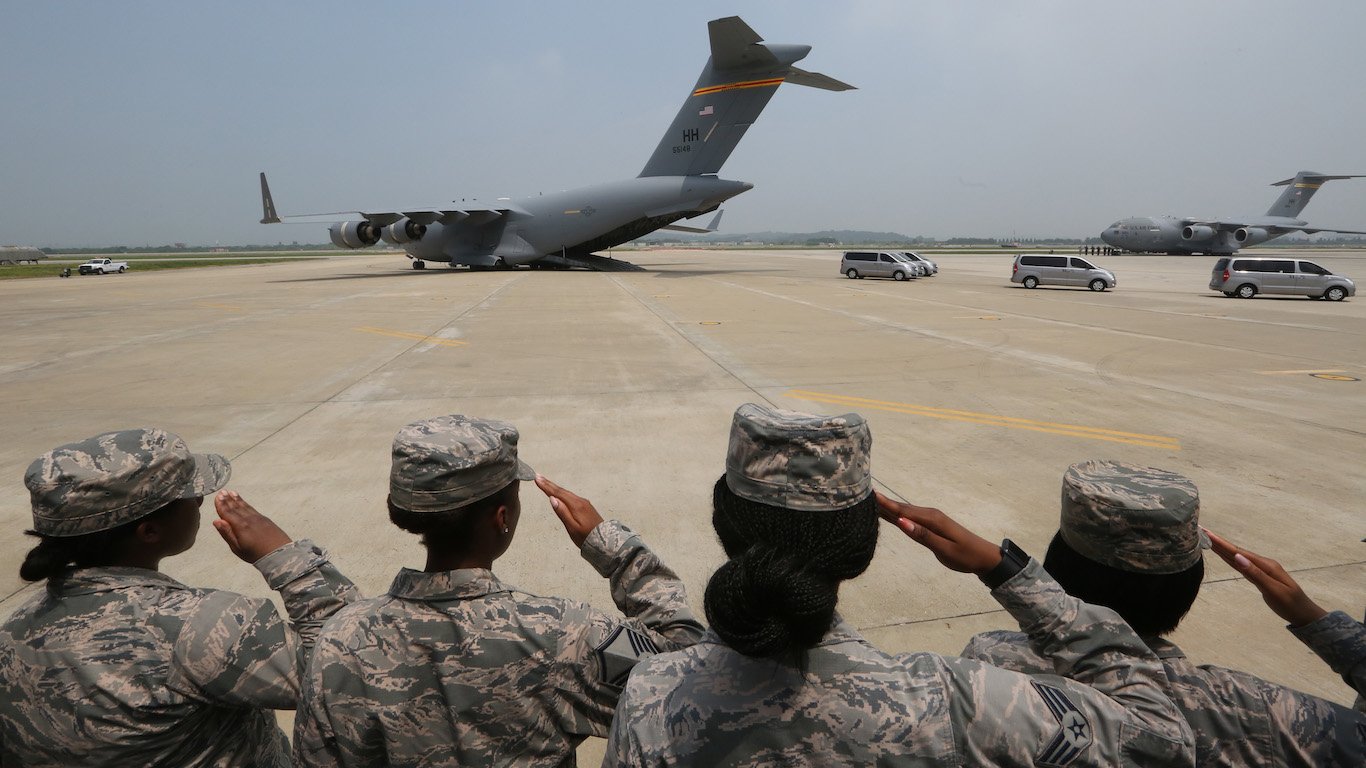
8. Pyeongtaek Cpx Area, South Korea
> Base size: 7,640 acres
> Cost of base: $10.0 million
> Service branch: Army
> Nearest city: Pyeongtaek
In June of 2018, the United States opened its largest military base in South Korea in the city of Pyeongtaek, about 40 miles south of the capital of Seoul. The facility, named Camp Humphreys, is the new headquarters of the U.S. Forces Korea (USFK). South Korea, which with its U.S. allies fought a war against communist North Korea and China in the early 1950s, is home to nine of the largest U.S. bases overseas.
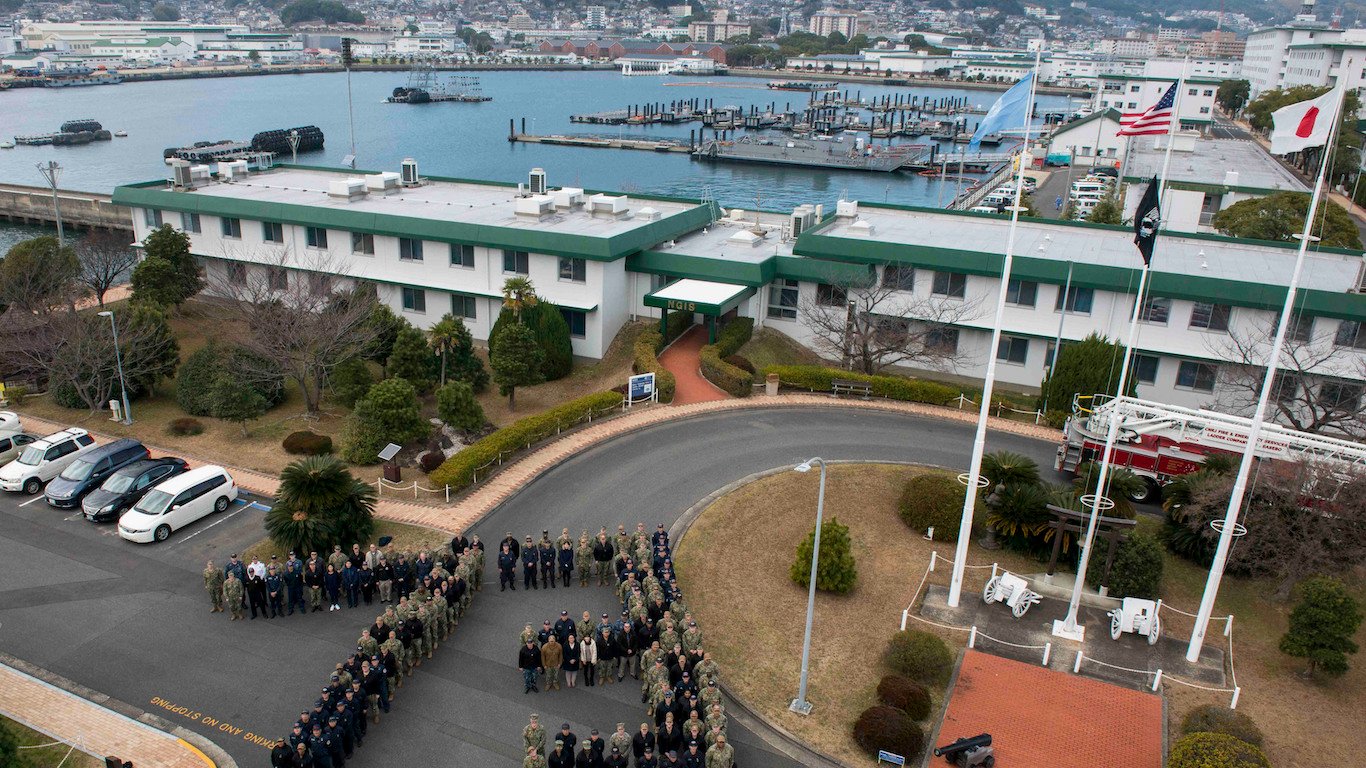
7. Commander Fleet Activities Sasebo, Japan
> Base size: 7,733 acres
> Cost of base: $1.8 billion
> Service branch: Navy
> Nearest city: Sasebo
Commander Fleet Activities Sasebo, Japan, on the island of Kyushu in the Nagasaki Prefecture, is an example of cooperation between the United States and Japan, where the ships of the Japan Maritime Self Defense Force and the American 7th Fleet share the port. Japan established a naval base there in 1889. The Japanese Empire employed 50,000 people at Sasebo during World War II, and after the United States took over the base in 1946, it served as the main launch area for the United Nations involved in the Korean War.
[in-text-ad-2]
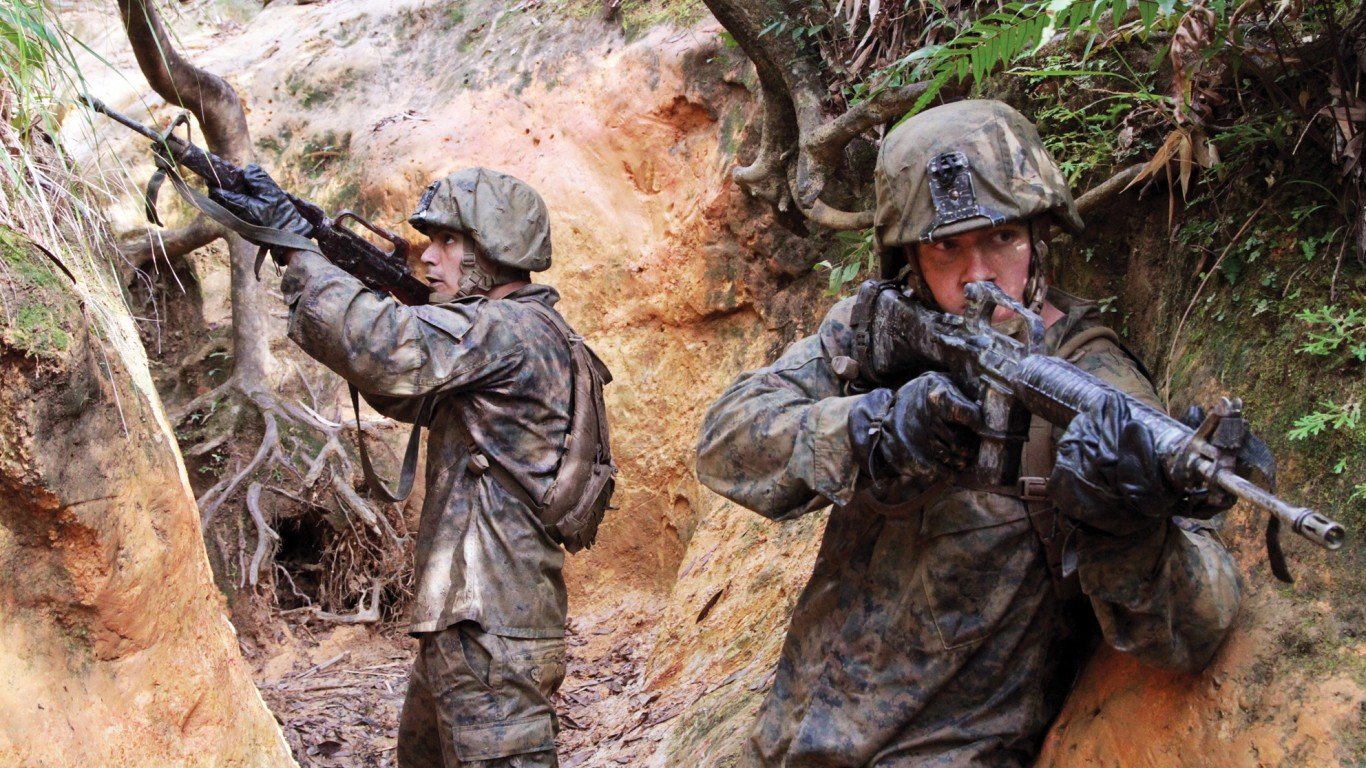
6. Camp Gonsalves, Japan
> Base size: 9,040 acres
> Cost of base: $43.1 million
> Service branch: Marine Corps
> Nearest city: Henoko Okinawa
Camp Gonsalves, commissioned in 1958, covers about 27 square miles of jungle, an important geographical feature for the American military to familiarize itself with jungle warfare in Vietnam in the 1960s. The camp was named after PFC Harold Gonsalves, a Marine who received the Medal of Honor for bravery during the battle for Okinawa in World War II. The camp also goes by the name of JWTC, short for Jungle Warfare Training Center.

5. Area C-HFR, Australia
> Base size: 9,463 acres
> Cost of base: N/A
> Service branch: Navy
> Nearest city: Exmouth
Area C-HFR is one of the communications facilities that the U.S. Navy jointly operates with Australian military forces in western Australia. HFR stands for high frequency receiver. The facility is the southernmost of three installations on a peninsula in Western Australia that separates the Exmouth Gulf from the Indian Ocean. The communications installation was set up to communicate with submarines and surface vessels in the Indian and western Pacific oceans.
[in-text-ad]
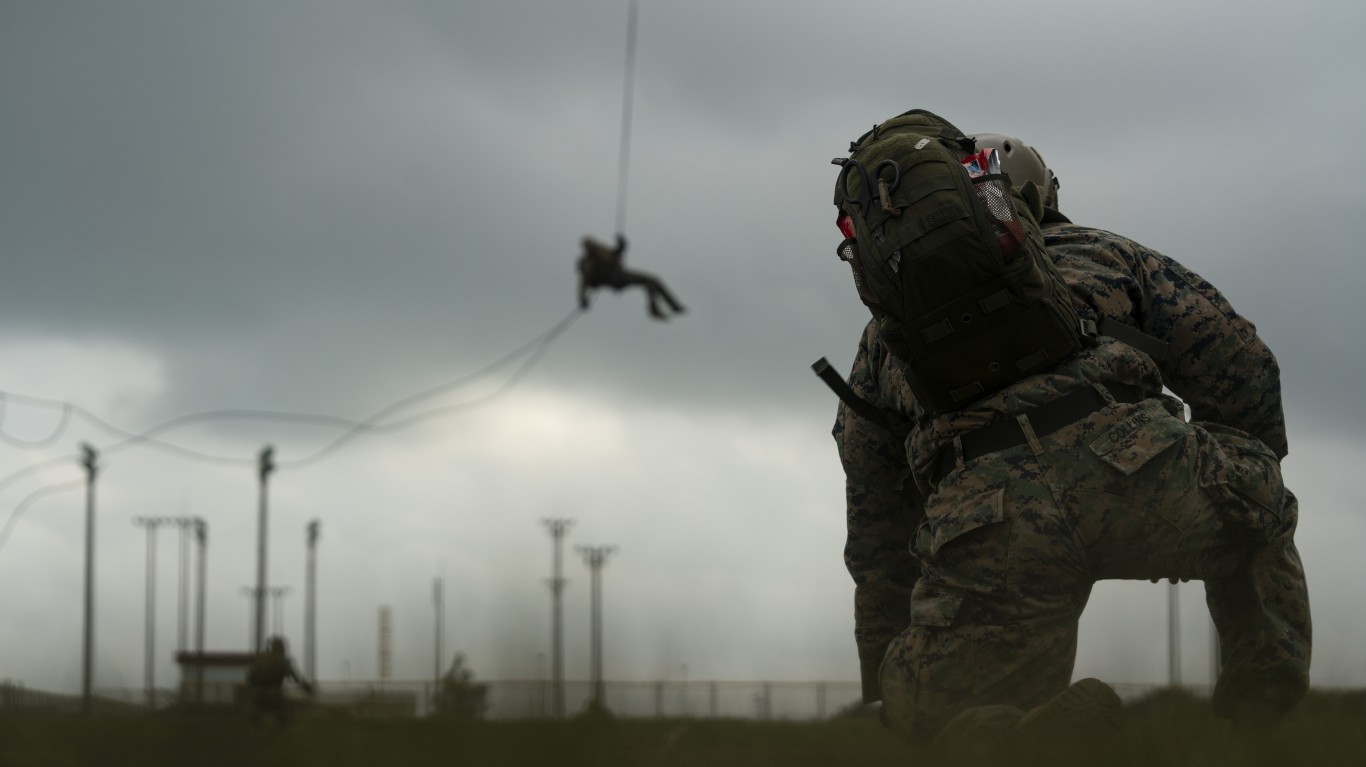
4. Camp Hansen, Japan
> Base size: 12,037 acres
> Cost of base: $2.7 billion
> Service branch: Marine Corps
> Nearest city: Onna Okinawa
Camp Hansen, named after Medal of Honor winner Marine Pvt. Dale M. Hansen for heroism during the battle for Okinawa, is located at the northern part of the island. It is one of several U.S. military bases on Okinawa. American troops today conduct training exercises using live fire there. Japanese troops use the base as well. Last year, the U.S. and Japanese government announced that 100 buildings will be constructed at Camp Hansen as part of relocation efforts to consolidate military facilities on the island.
3. Naval Station Guantanamo Bay, Guantanamo Bay
> Base size: 28,817 acres
> Cost of base: $4.6 billion
> Service branch: Navy
> Nearest city: Guantanamo Bay
The naval station at Guantanamo Bay, sometimes truncated to “Gitmo,” is located in southeastern Cuba. The United States has leased the land the base sits on from Cuba since 1903, after the Spanish-American War, and the lease can be terminated only by mutual agreement. The two countries signed a perpetual lease in 1934 that costs America $4,085 a year. Cuba views the facility as a vestige of American imperialism. Detention facilities at the base are used to house combatants involved in the war on terror. About 6,000 people live on the Guantanamo Bay naval base, and more than a third are Jamaican and Filipino workers.
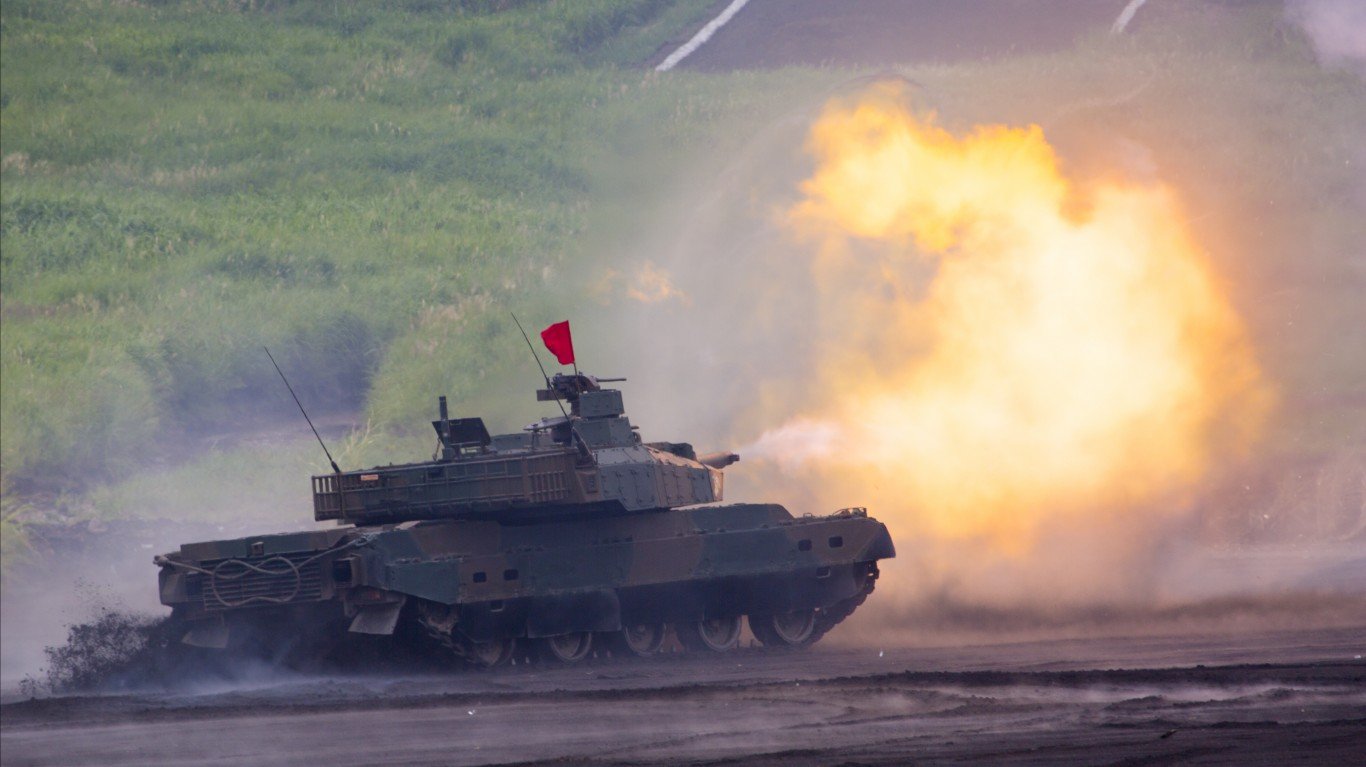
2. Camp Fuji Japan, Japan
> Base size: 33,384 acres
> Cost of base: $432.9 million
> Service branch: Marine Corps
> Nearest city: Fuji
Camp Fuji is located on the island of Honshu and is less than two-hours from Tokyo. The area of present-day Camp Fuji was used as a training ground for samurai warriors since at least the late 12th century during the Kamakura Feudal Government era. The Fuji Maneuver Area is used by both the U.S. and Japanese military and it contains live-fire ranges. The U.S. Army trained at the camp before it was deployed during the Korean War, before the Marines and Japanese defense forces took over the camp in the 1950s.
[in-text-ad-2]
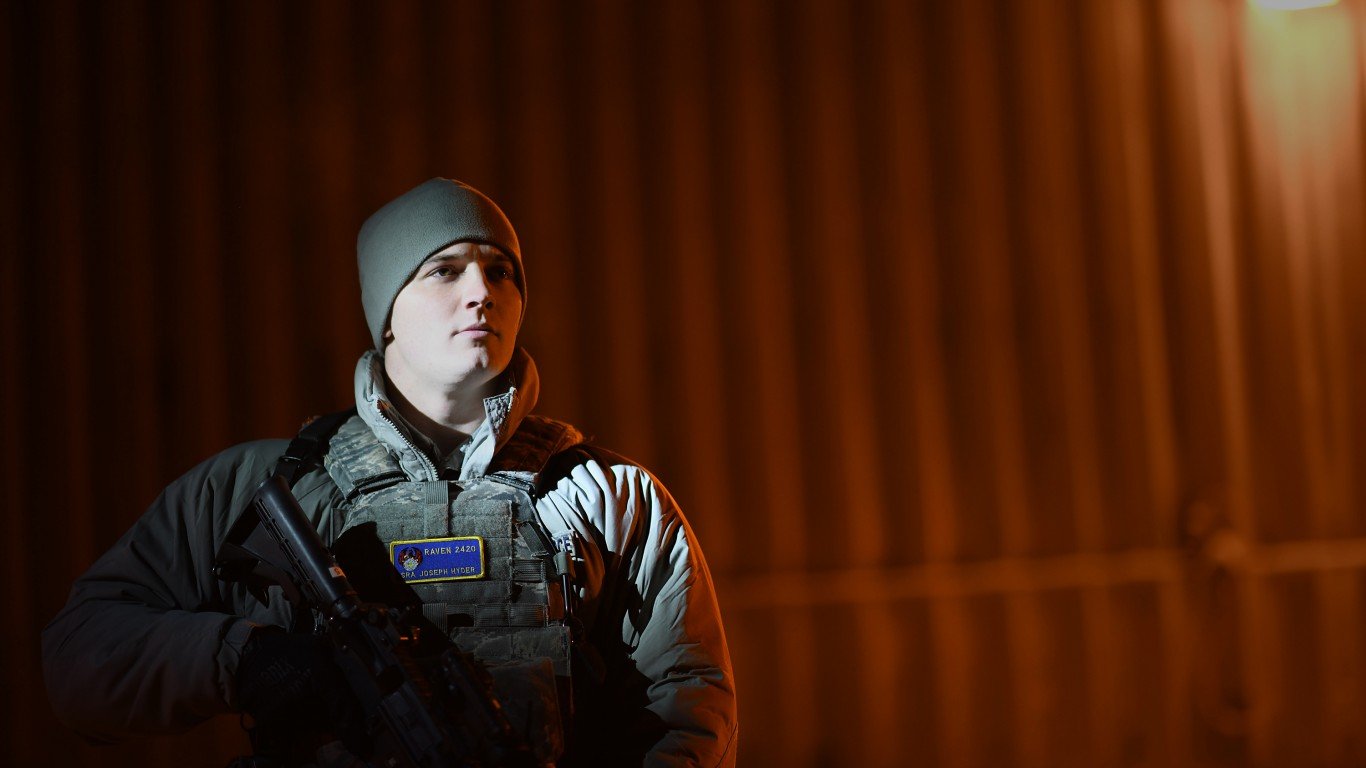
1. Thule Air Base, Greenland
> Base size: 233,034 acres
> Cost of base: $4.7 billion
> Service branch: Air Force
> Nearest city: Thule
Thule Air Base in Greenland is by far the largest military base overseas by physical size. It also enjoys another superlative — it is the northernmost base of any U.S. installation, 750 miles from the Arctic Circle. Thule, headquarters of the 821st Air Base Group, is one of the most isolated bases in the world. It was originally built for defense purposes during the Cold War. Because of saber-rattling from North Korea and renewed concerns over Russian territorial ambitions, the United States recently completed an overhaul of missile defense systems there. Its radar system got a $40 million software upgrade.
Take This Retirement Quiz To Get Matched With An Advisor Now (Sponsored)
Are you ready for retirement? Planning for retirement can be overwhelming, that’s why it could be a good idea to speak to a fiduciary financial advisor about your goals today.
Start by taking this retirement quiz right here from SmartAsset that will match you with up to 3 financial advisors that serve your area and beyond in 5 minutes. Smart Asset is now matching over 50,000 people a month.
Click here now to get started.
Thank you for reading! Have some feedback for us?
Contact the 24/7 Wall St. editorial team.

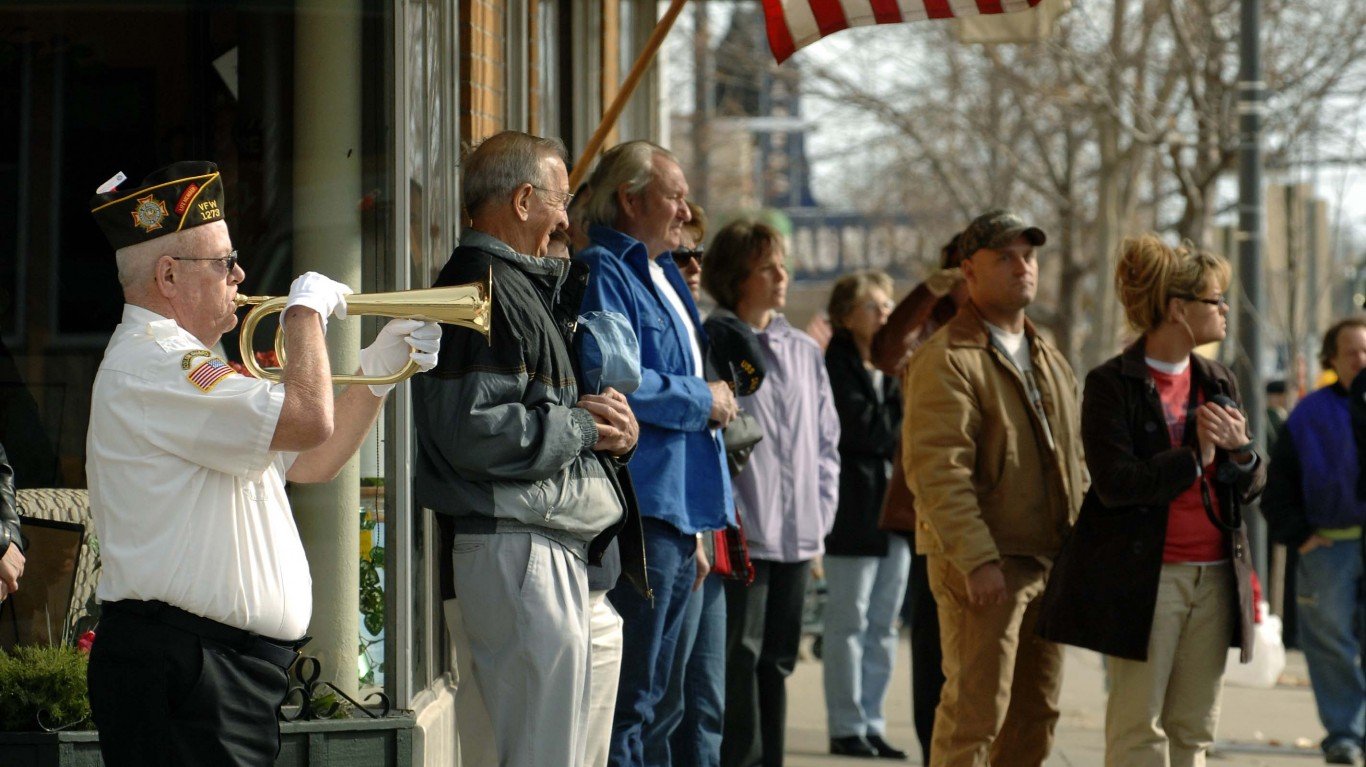 24/7 Wall St.
24/7 Wall St.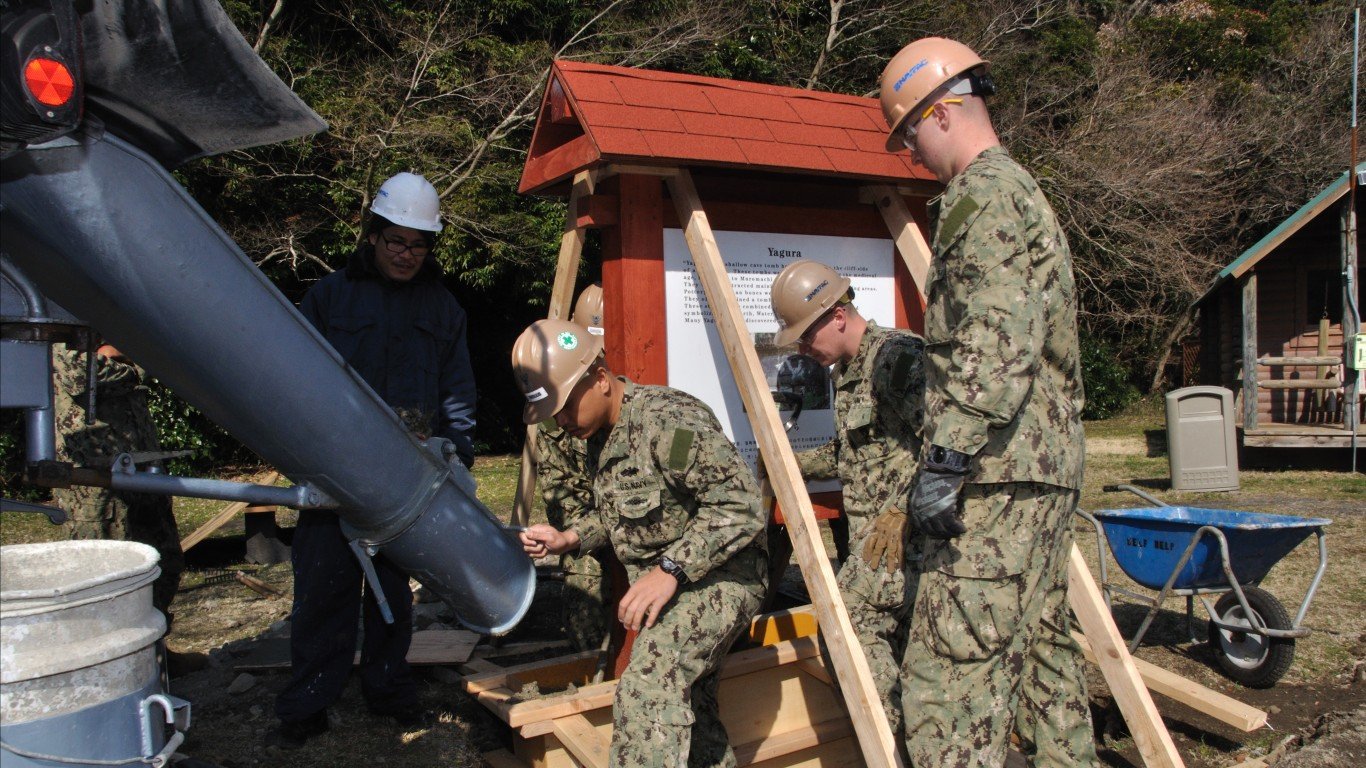
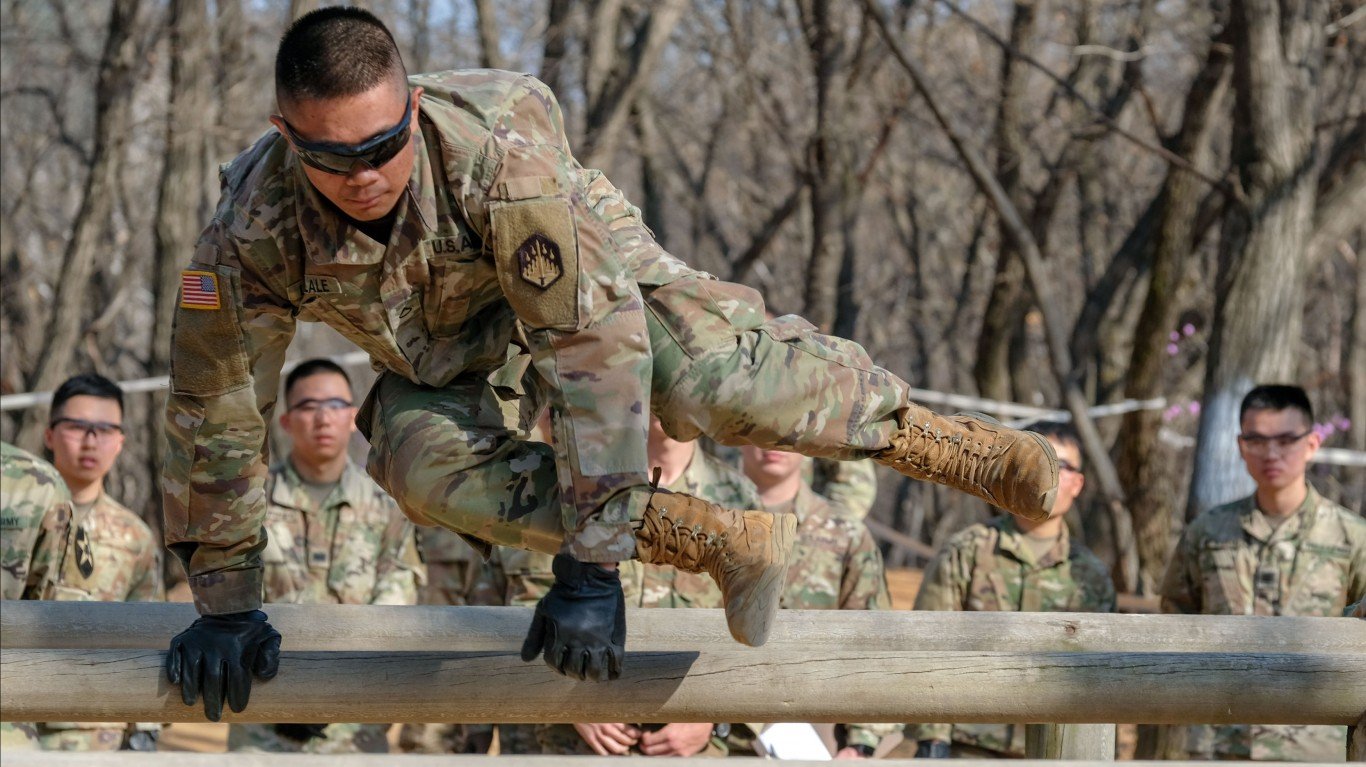
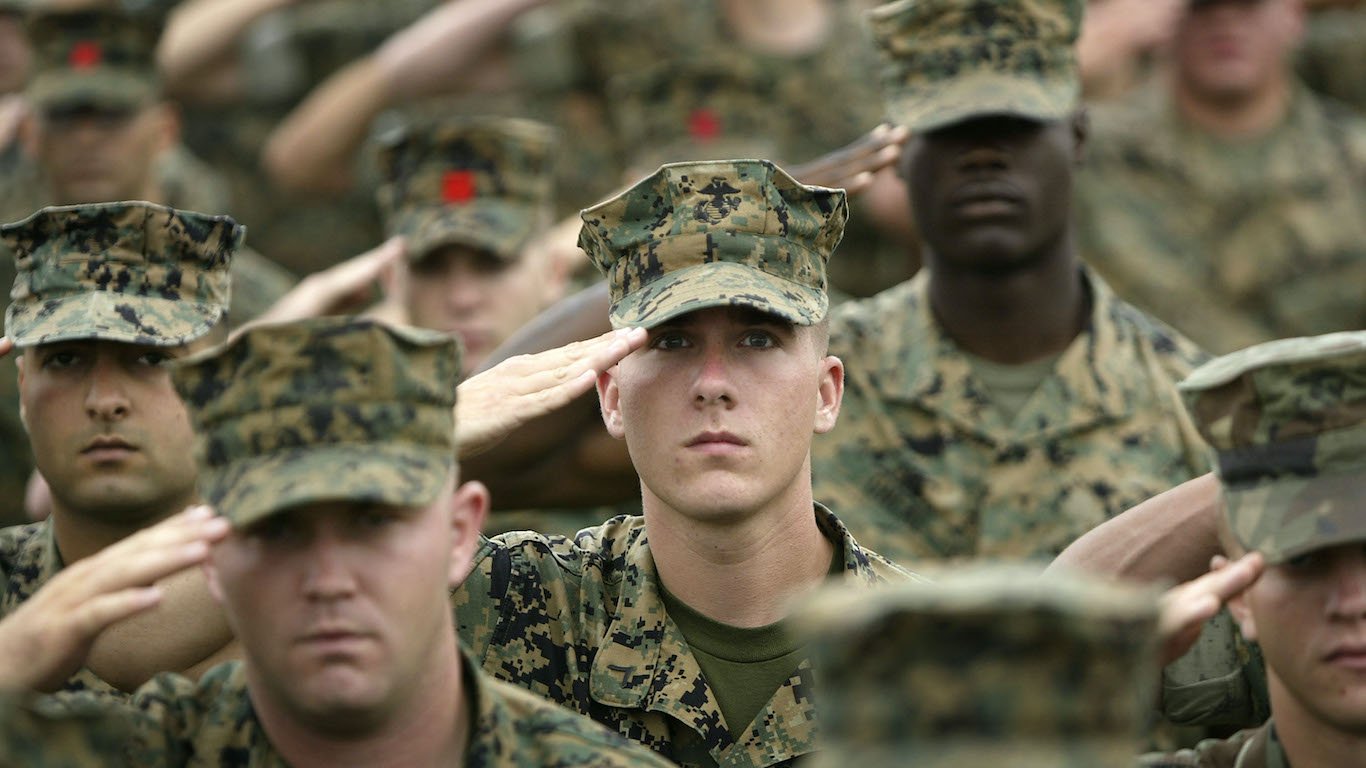 24/7 Wall St.
24/7 Wall St.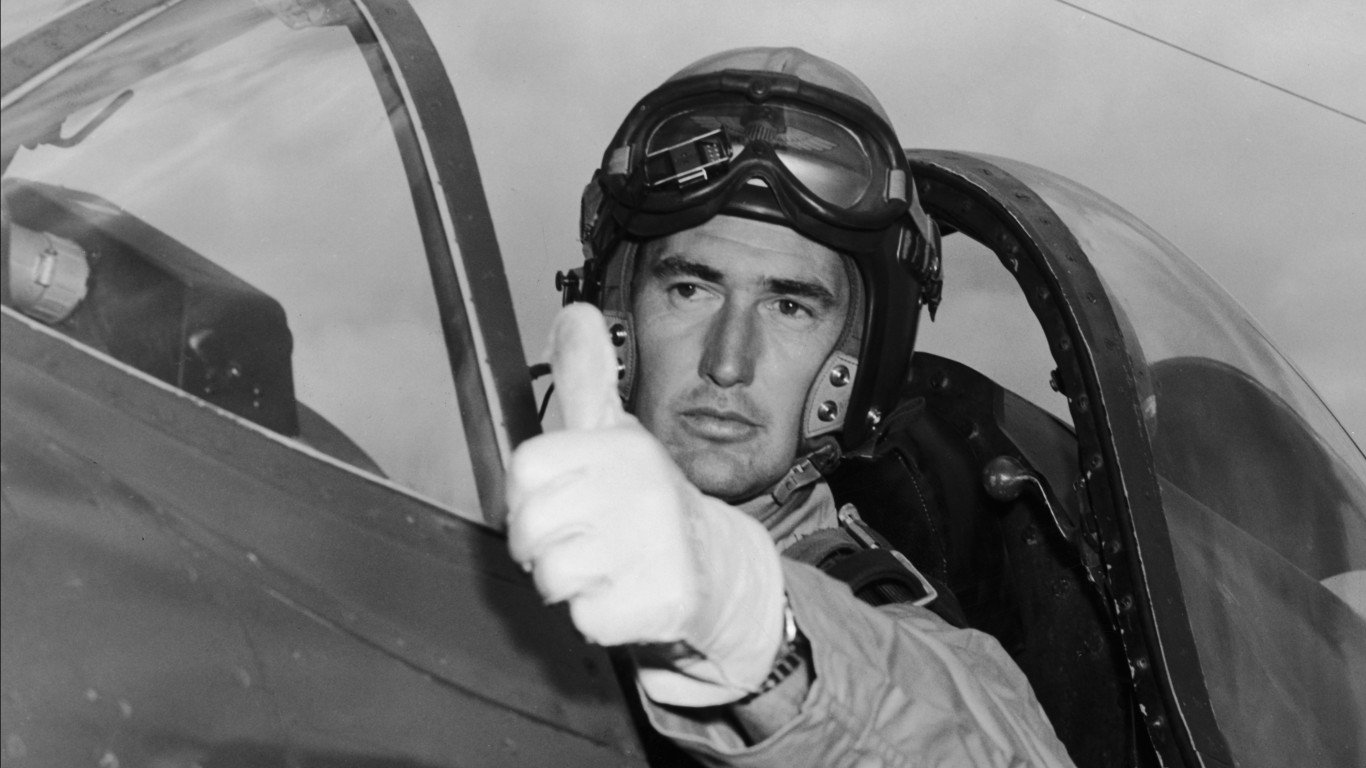 24/7 Wall St.
24/7 Wall St.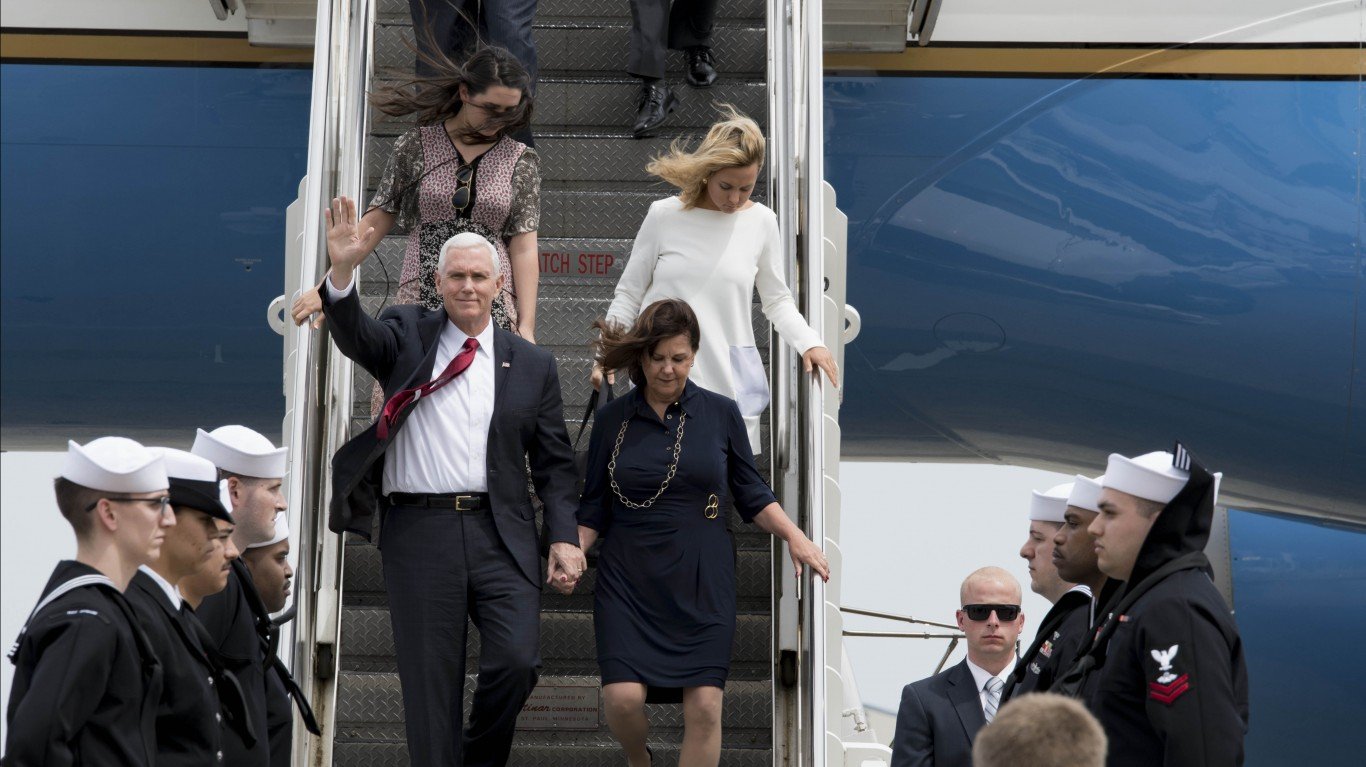
 24/7 Wall St.
24/7 Wall St.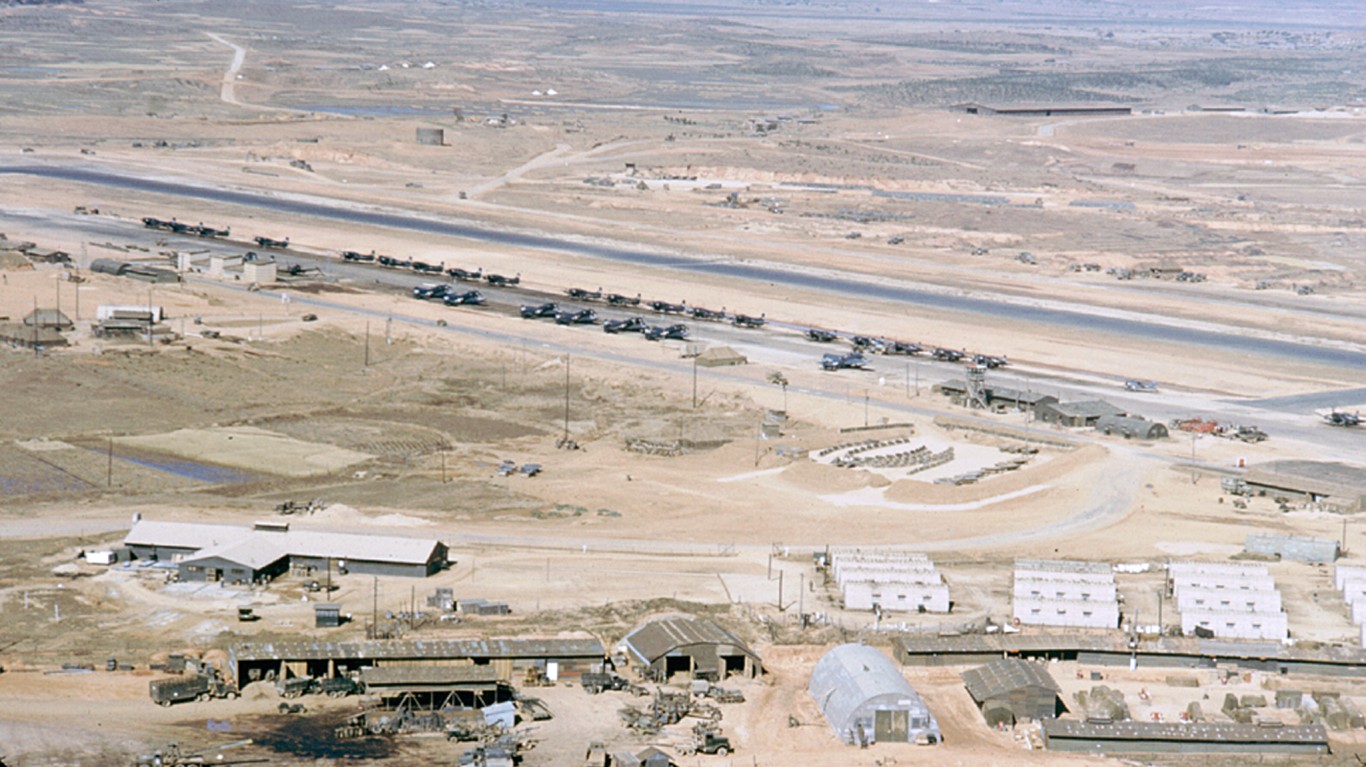
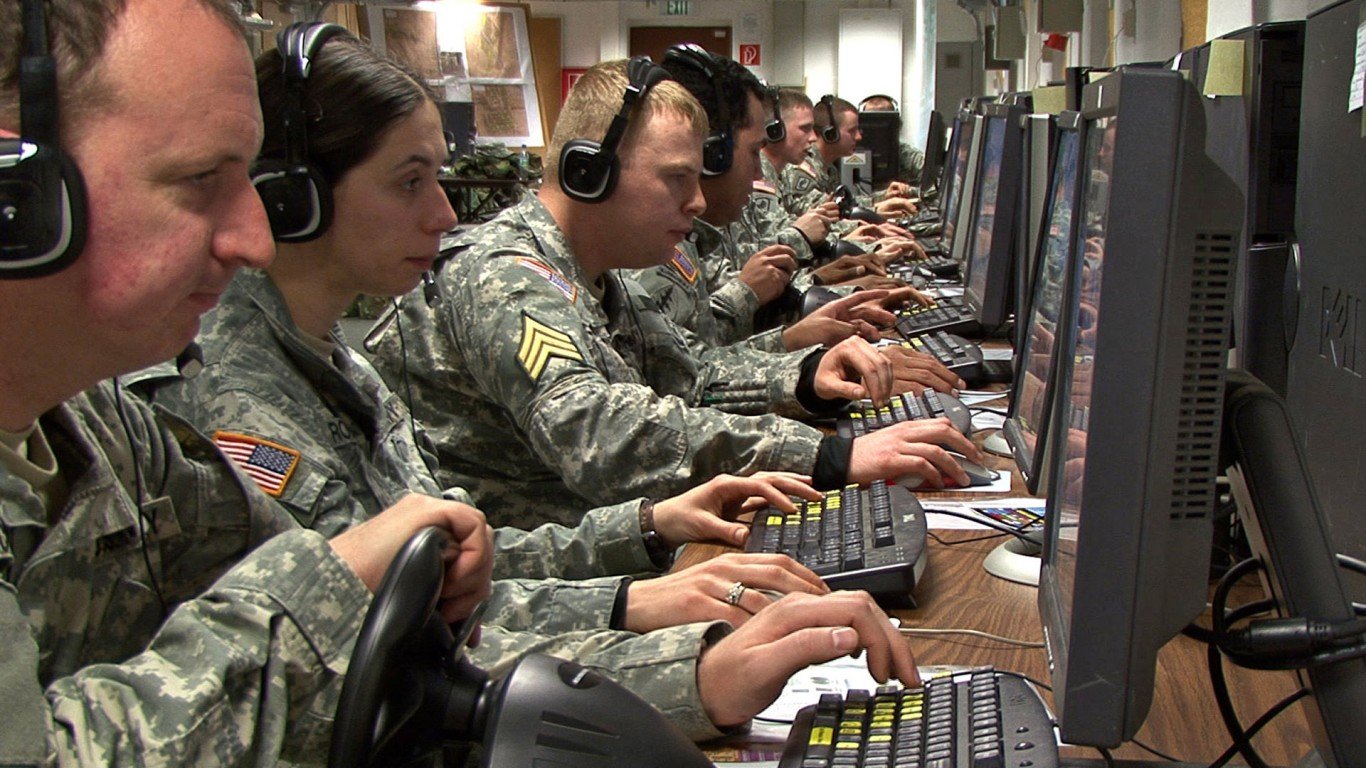 24/7 Wall St.
24/7 Wall St.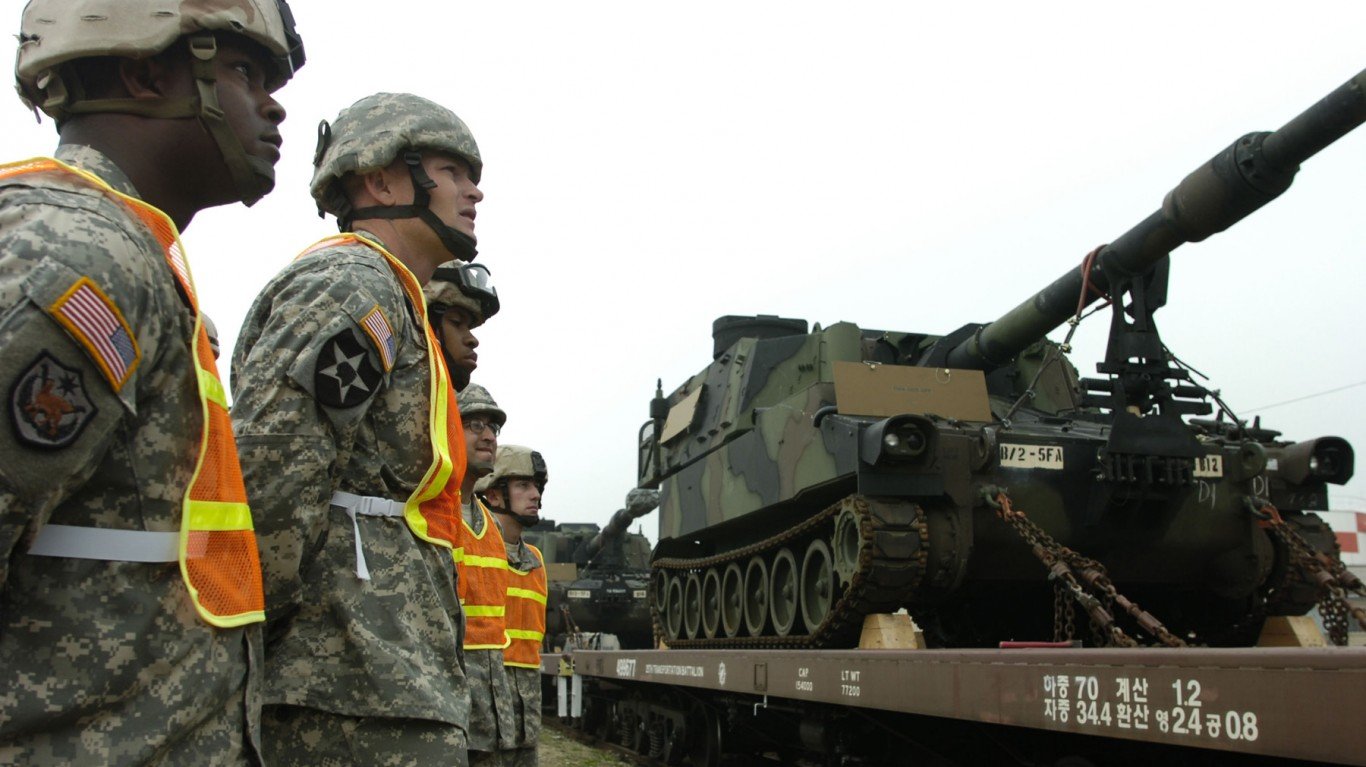



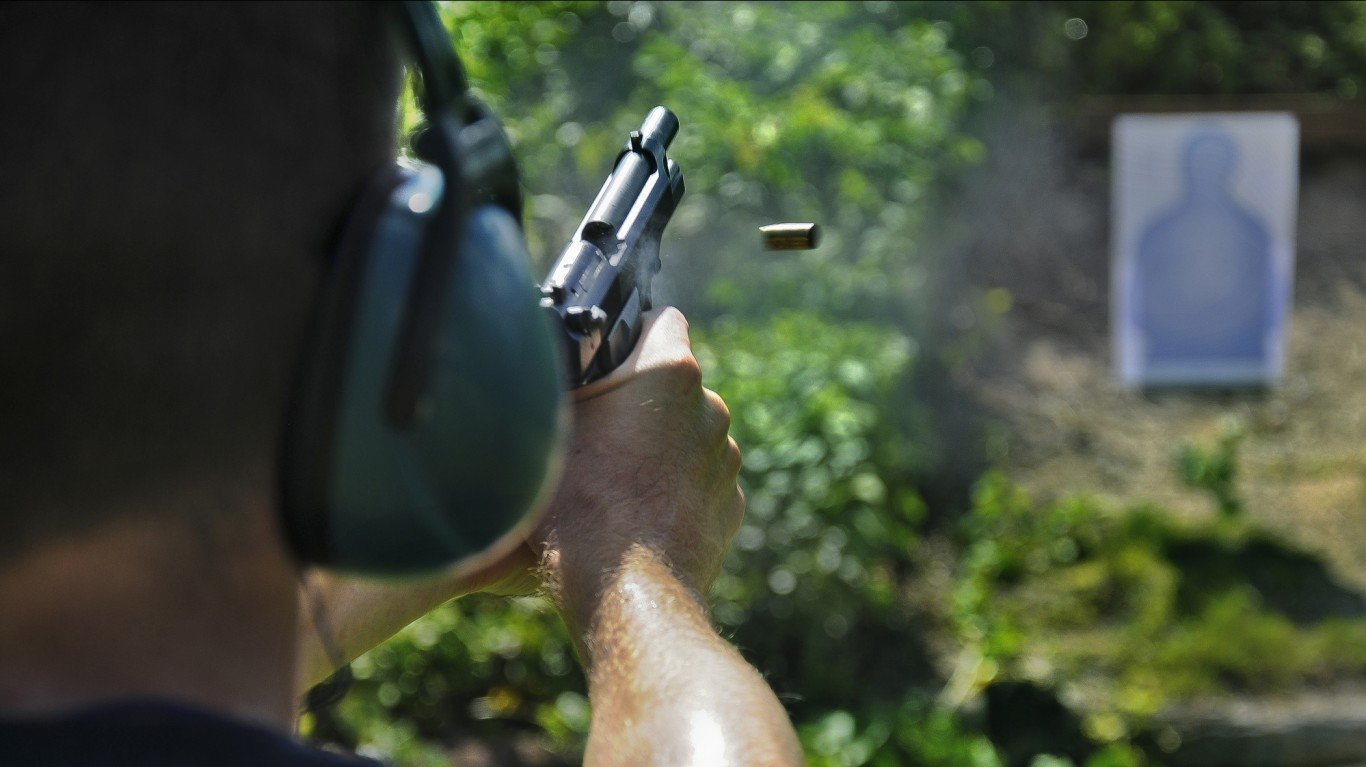
 24/7 Wall St.
24/7 Wall St.